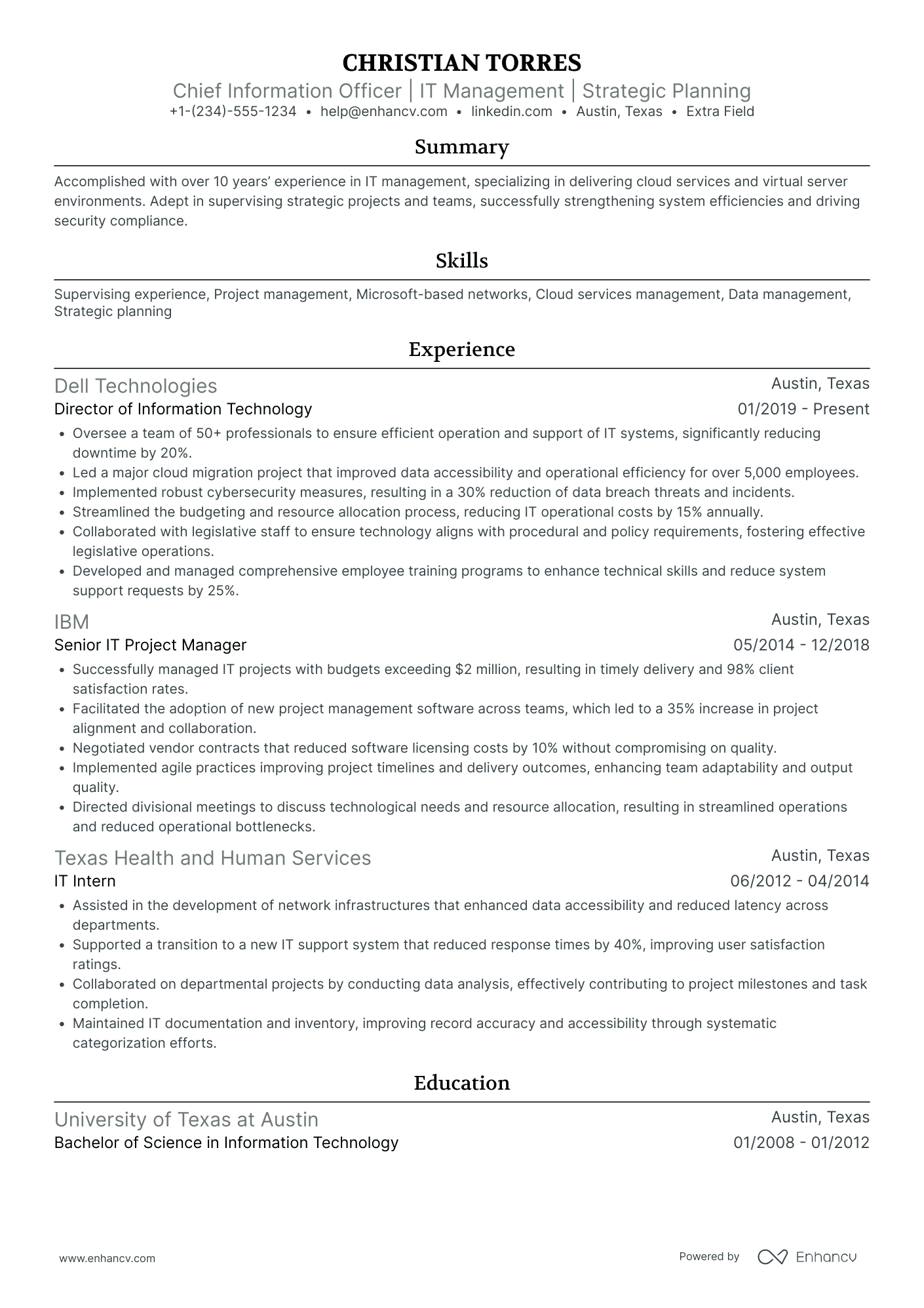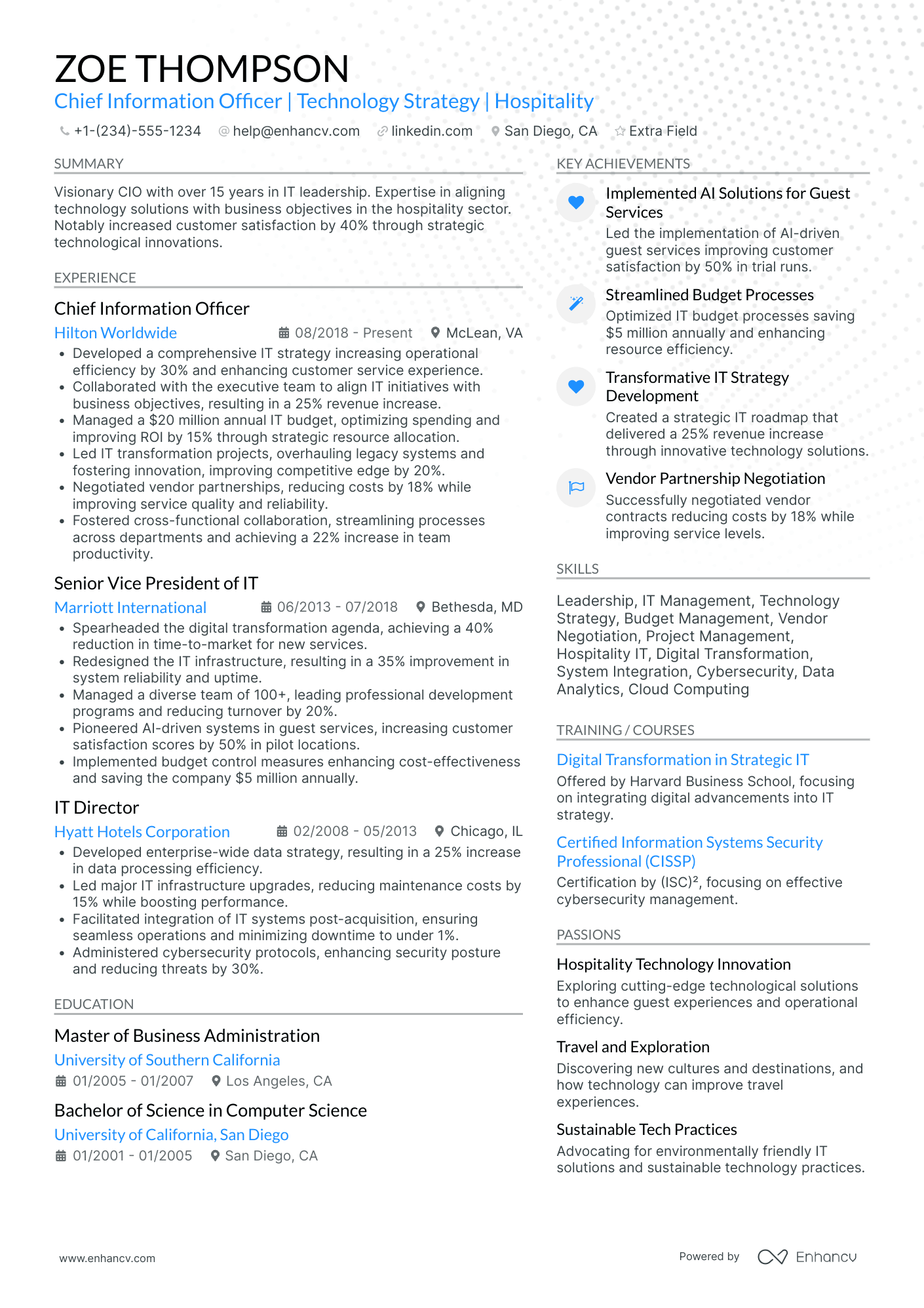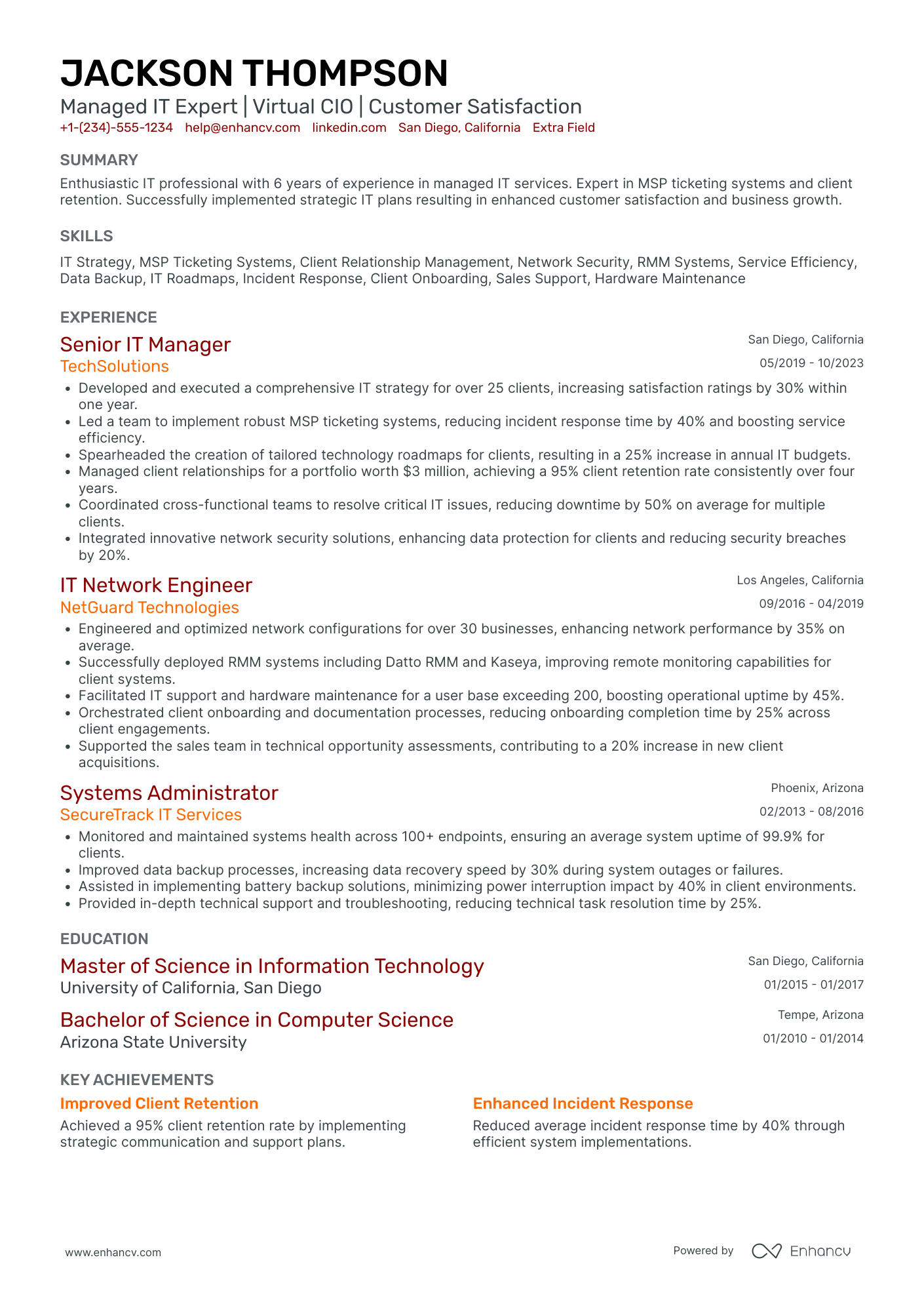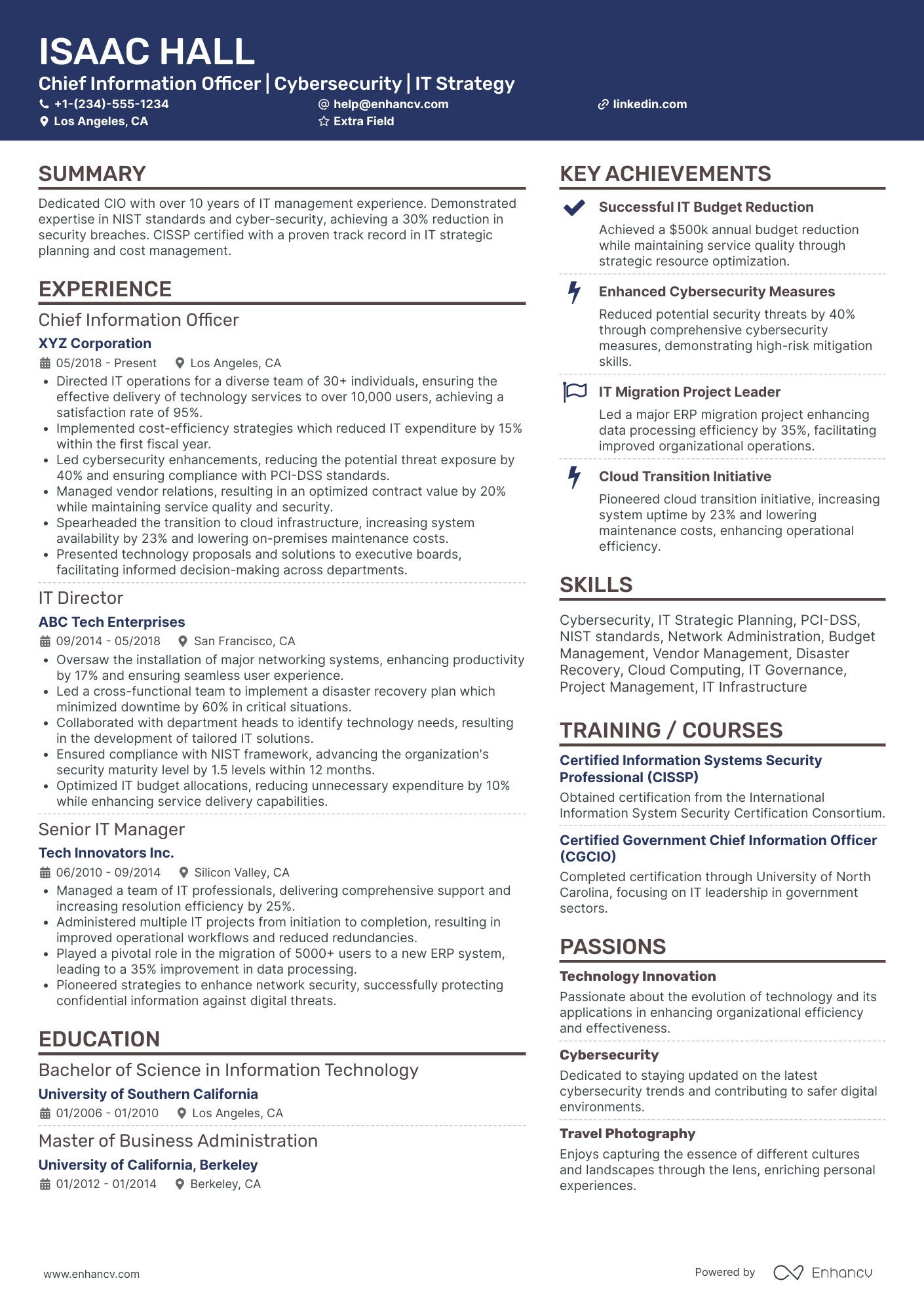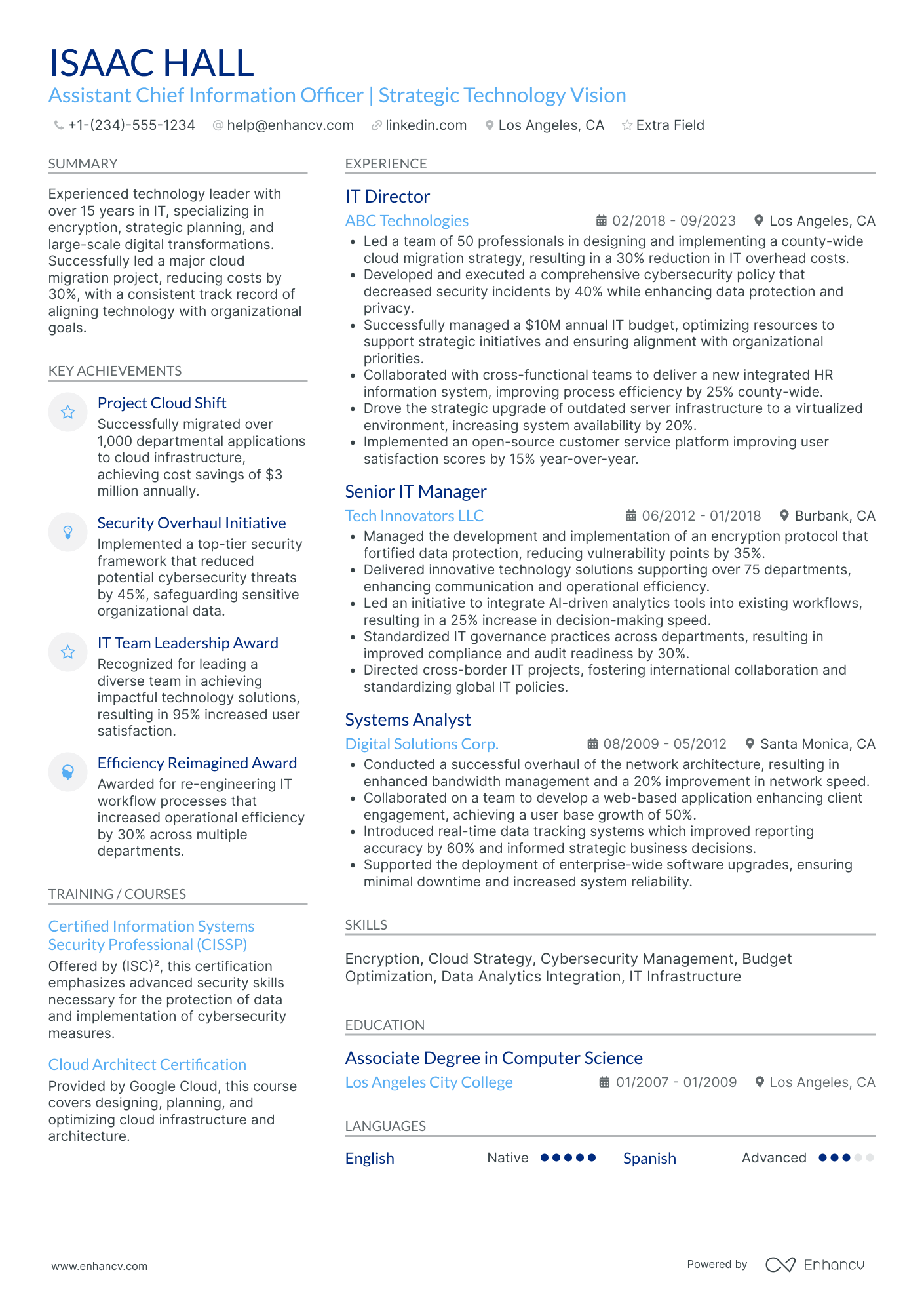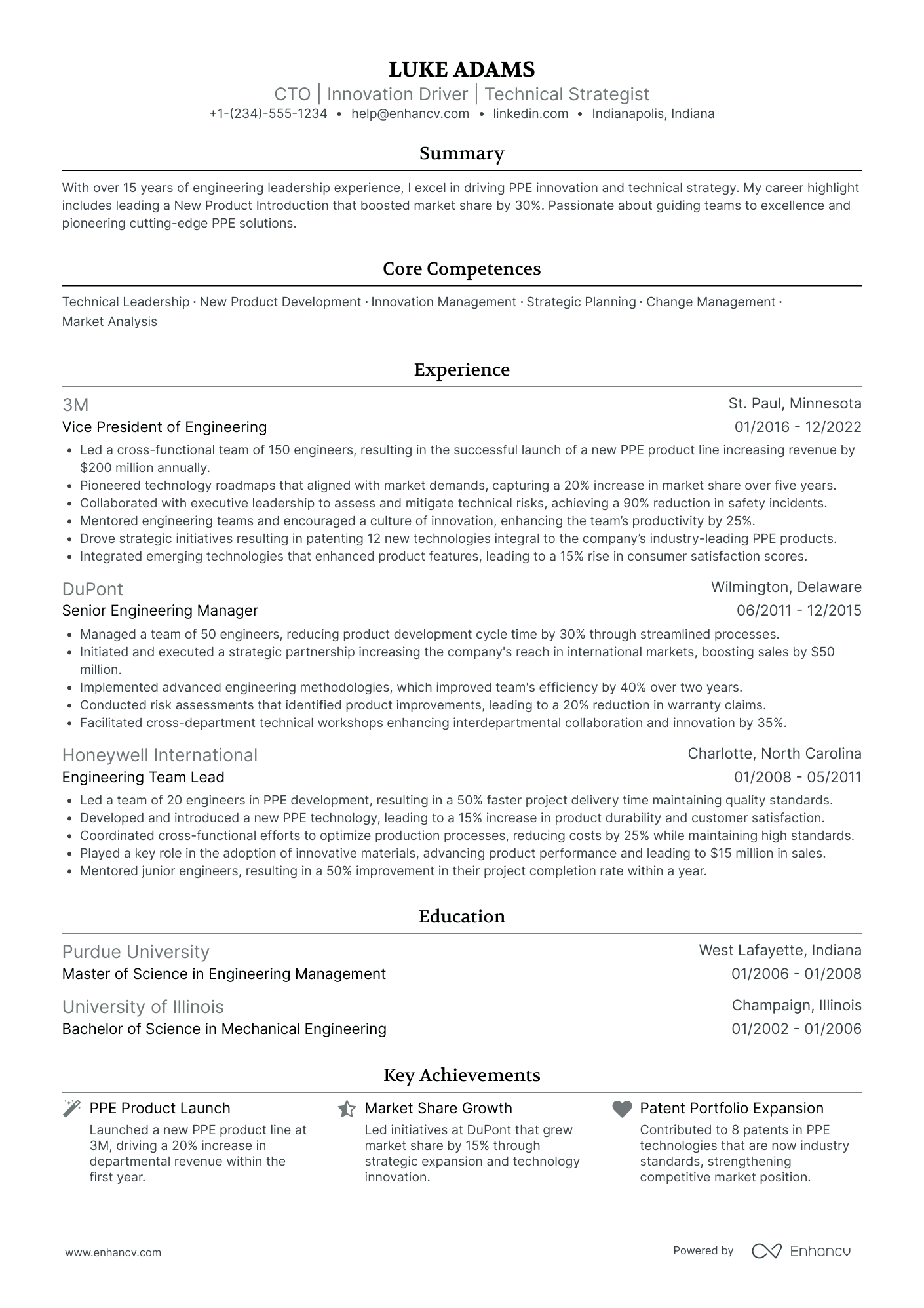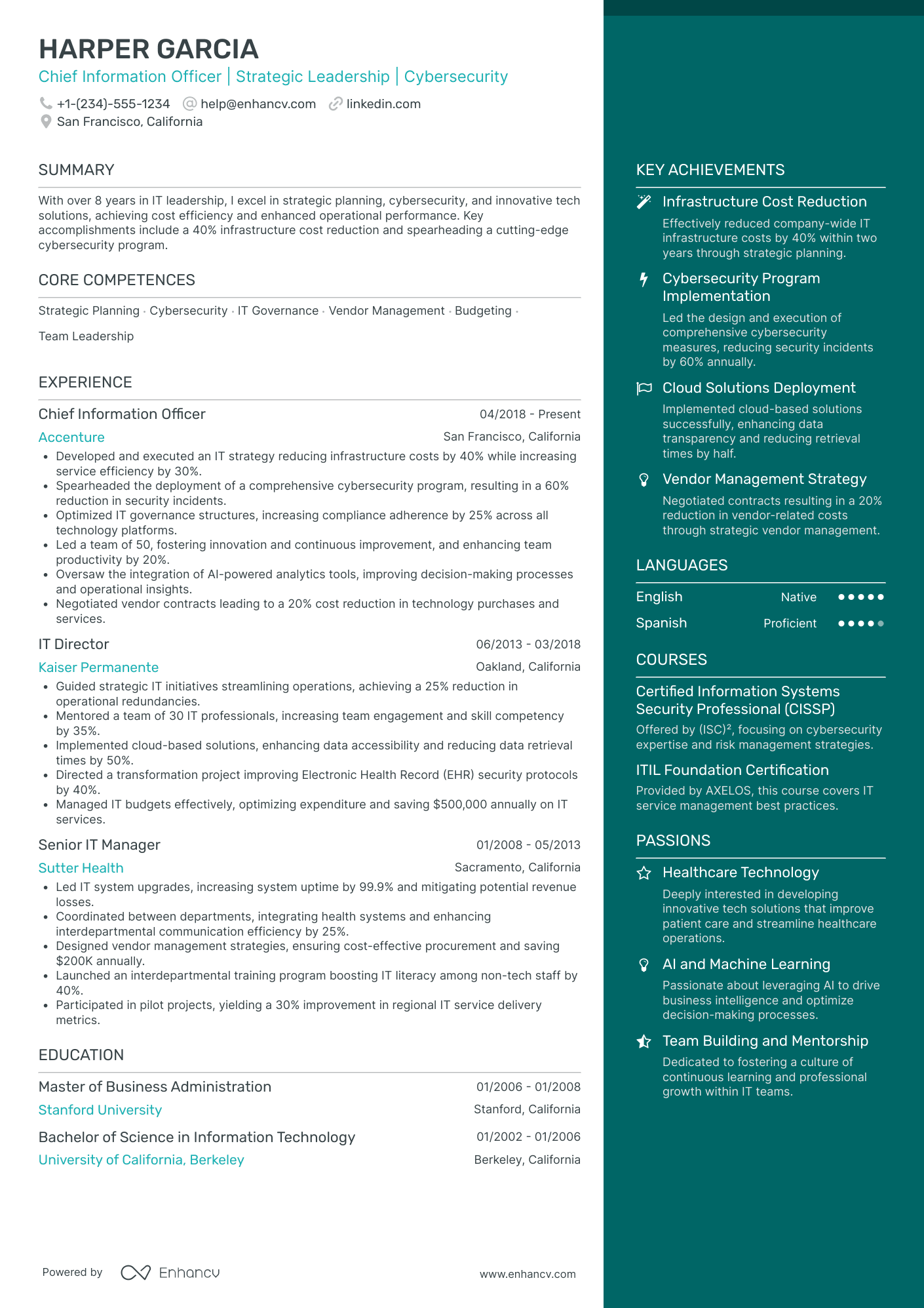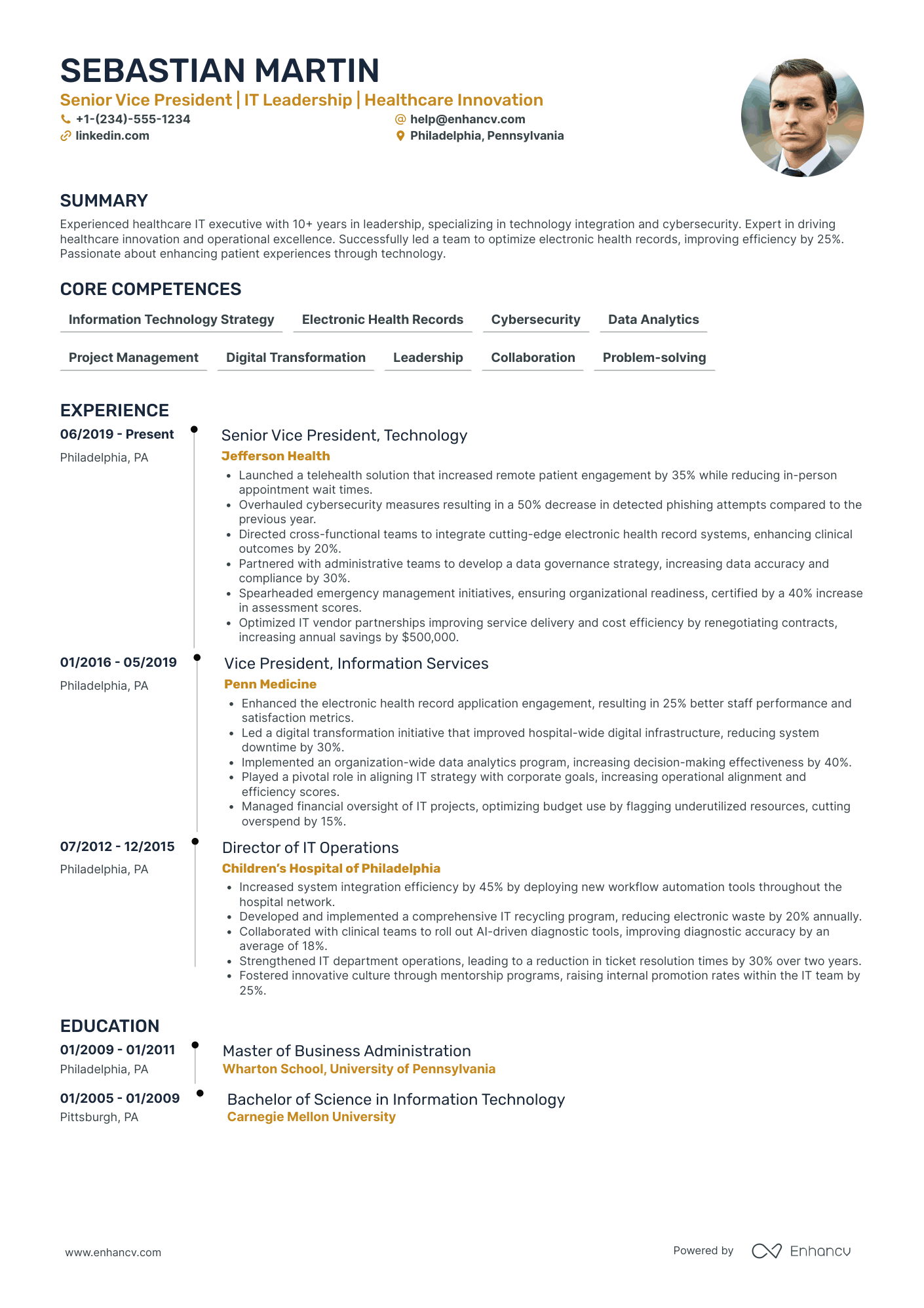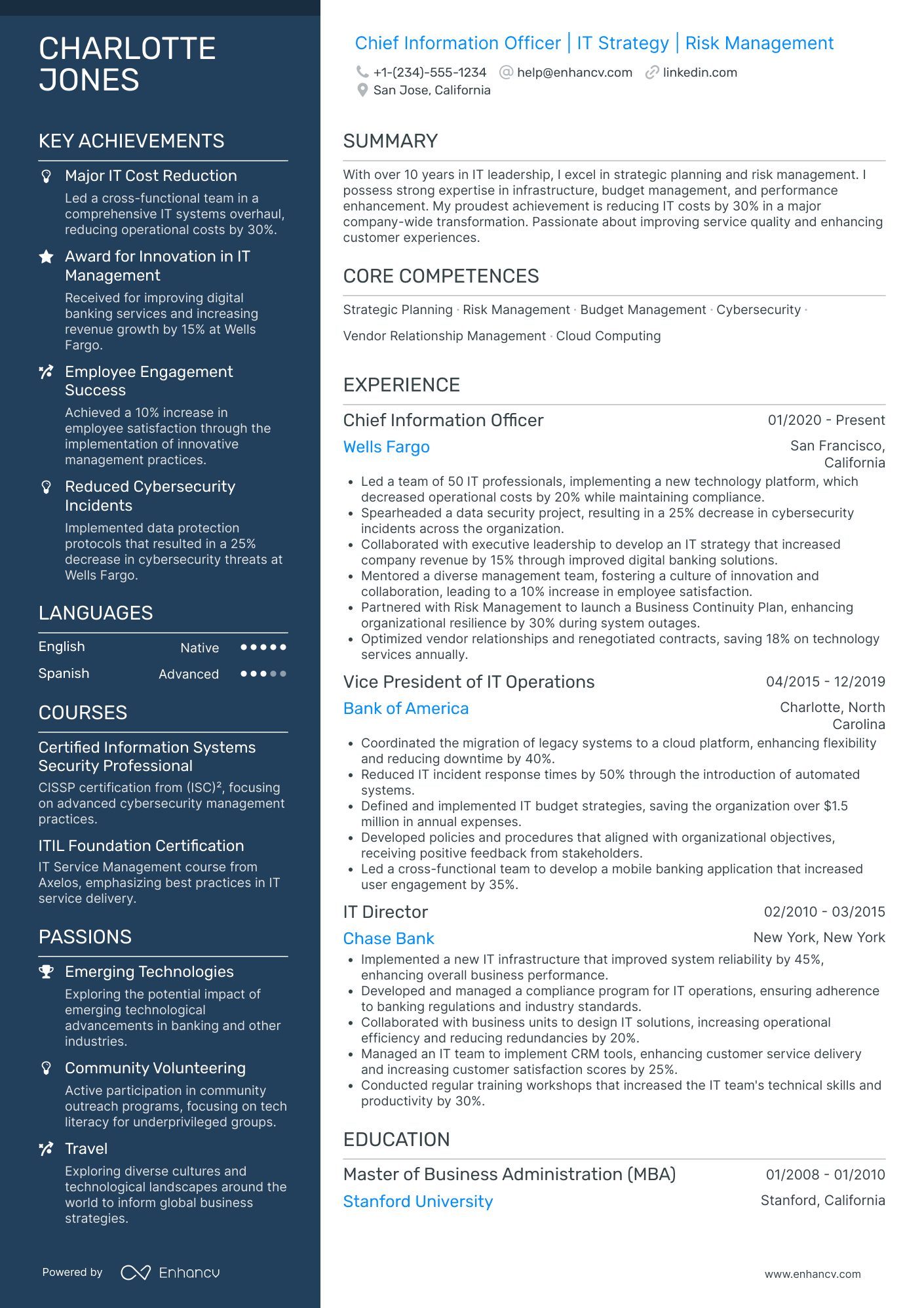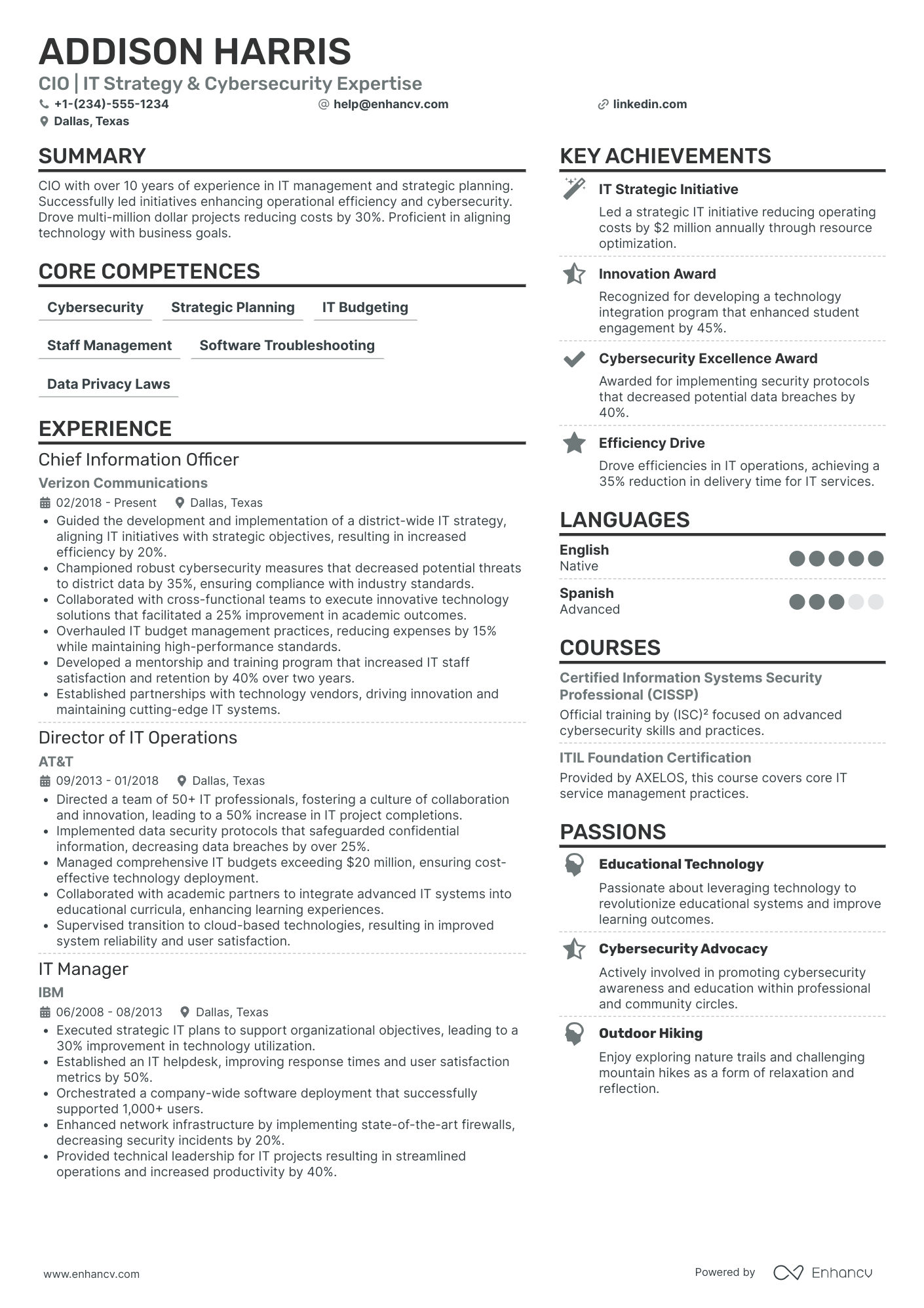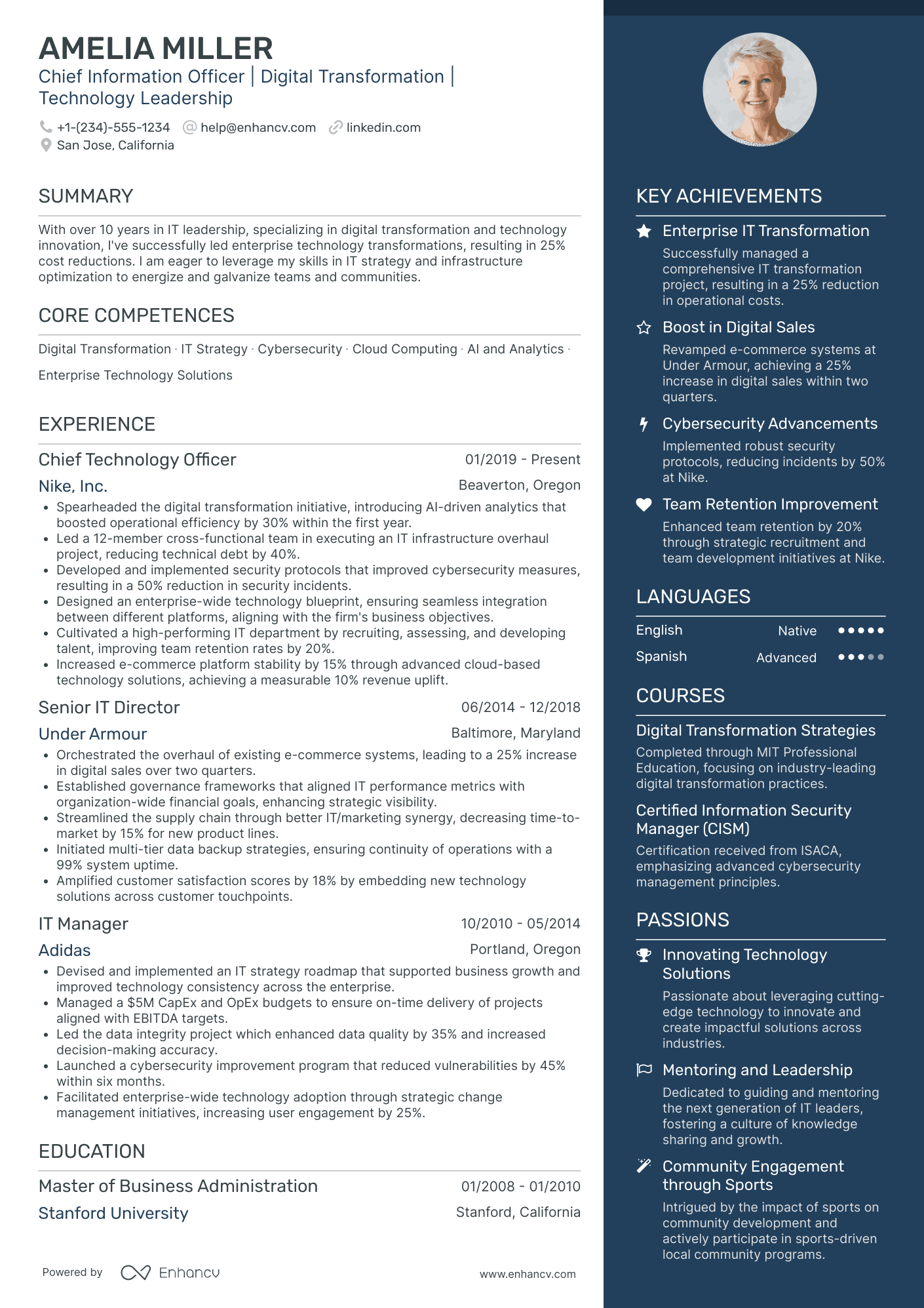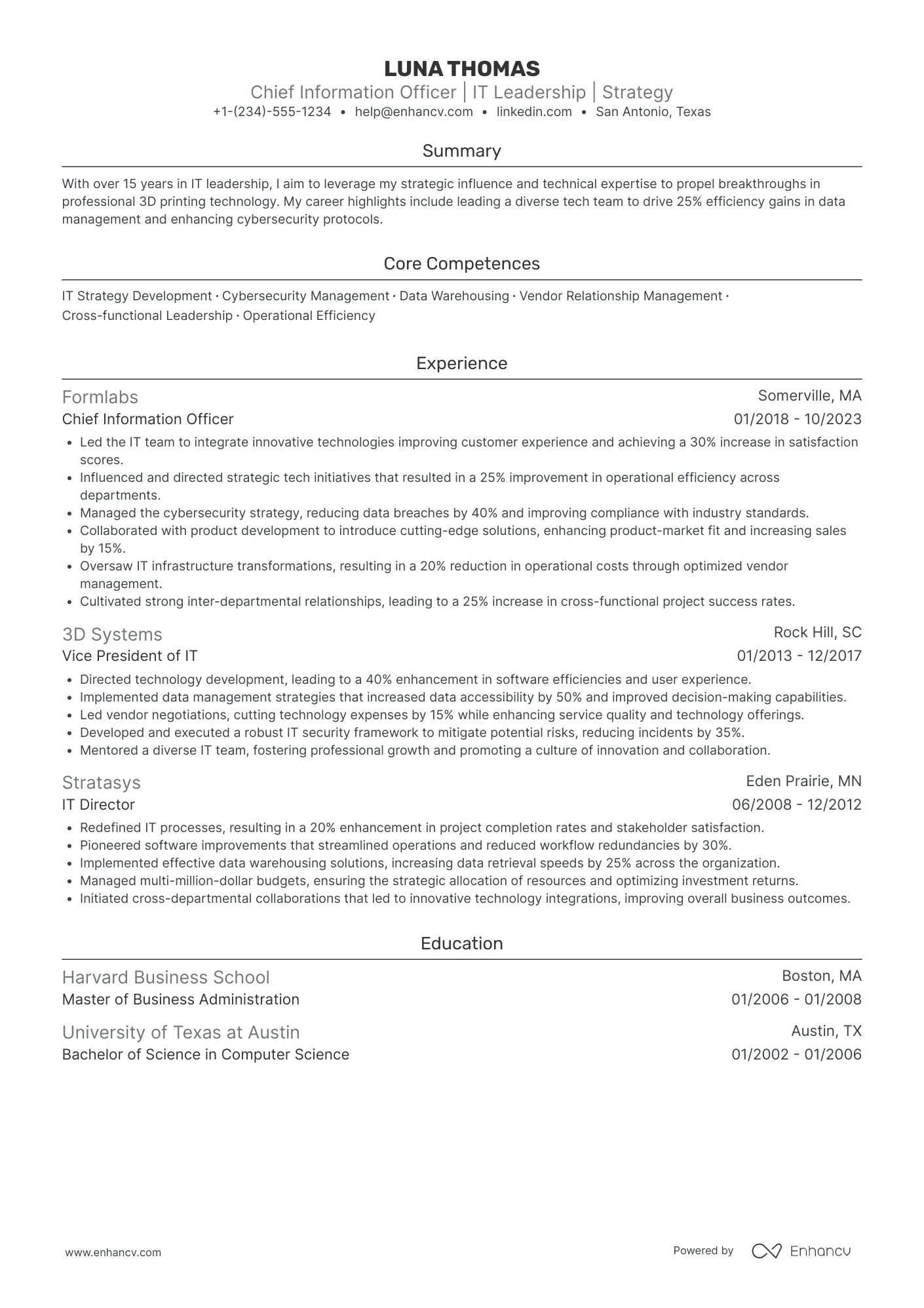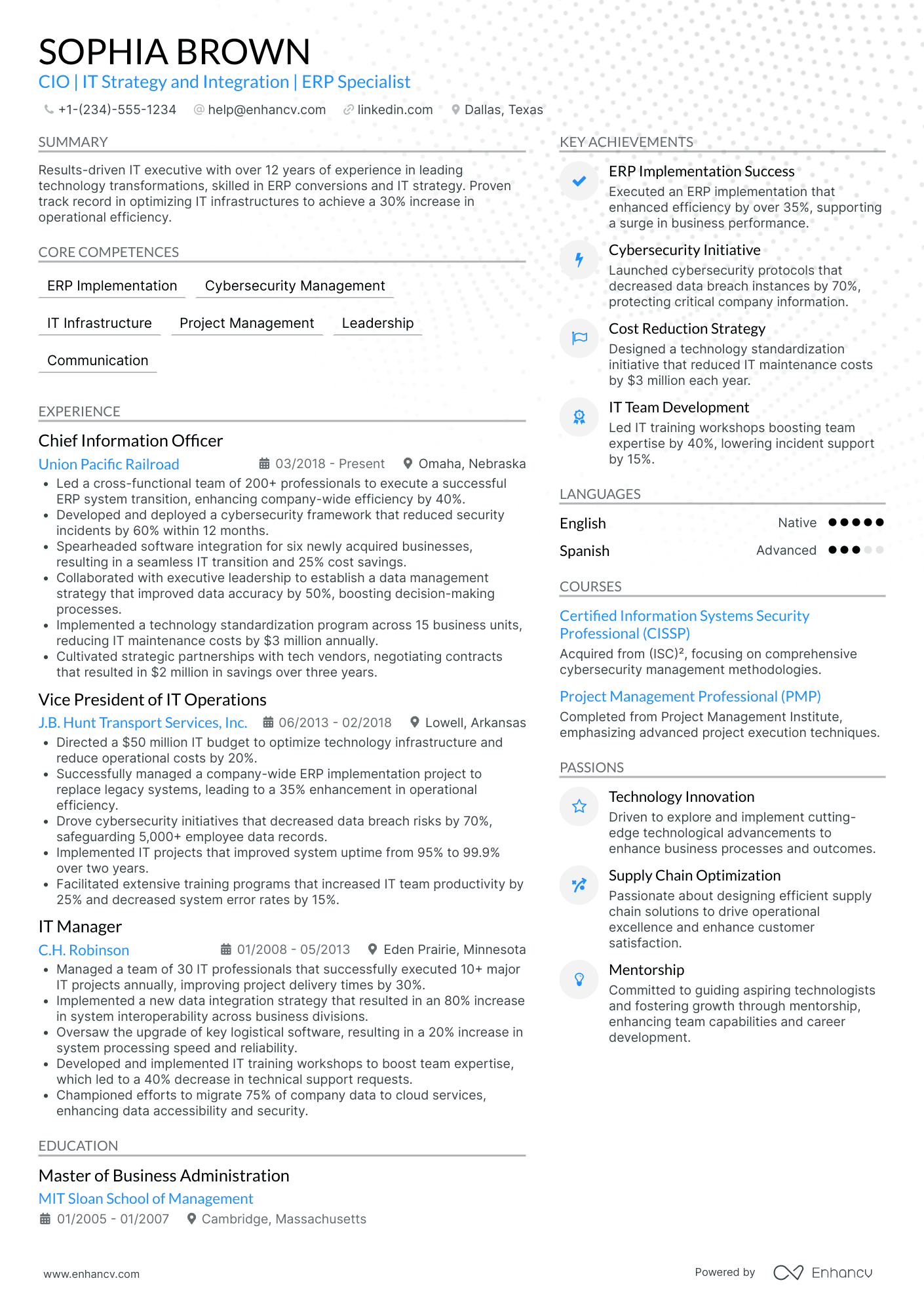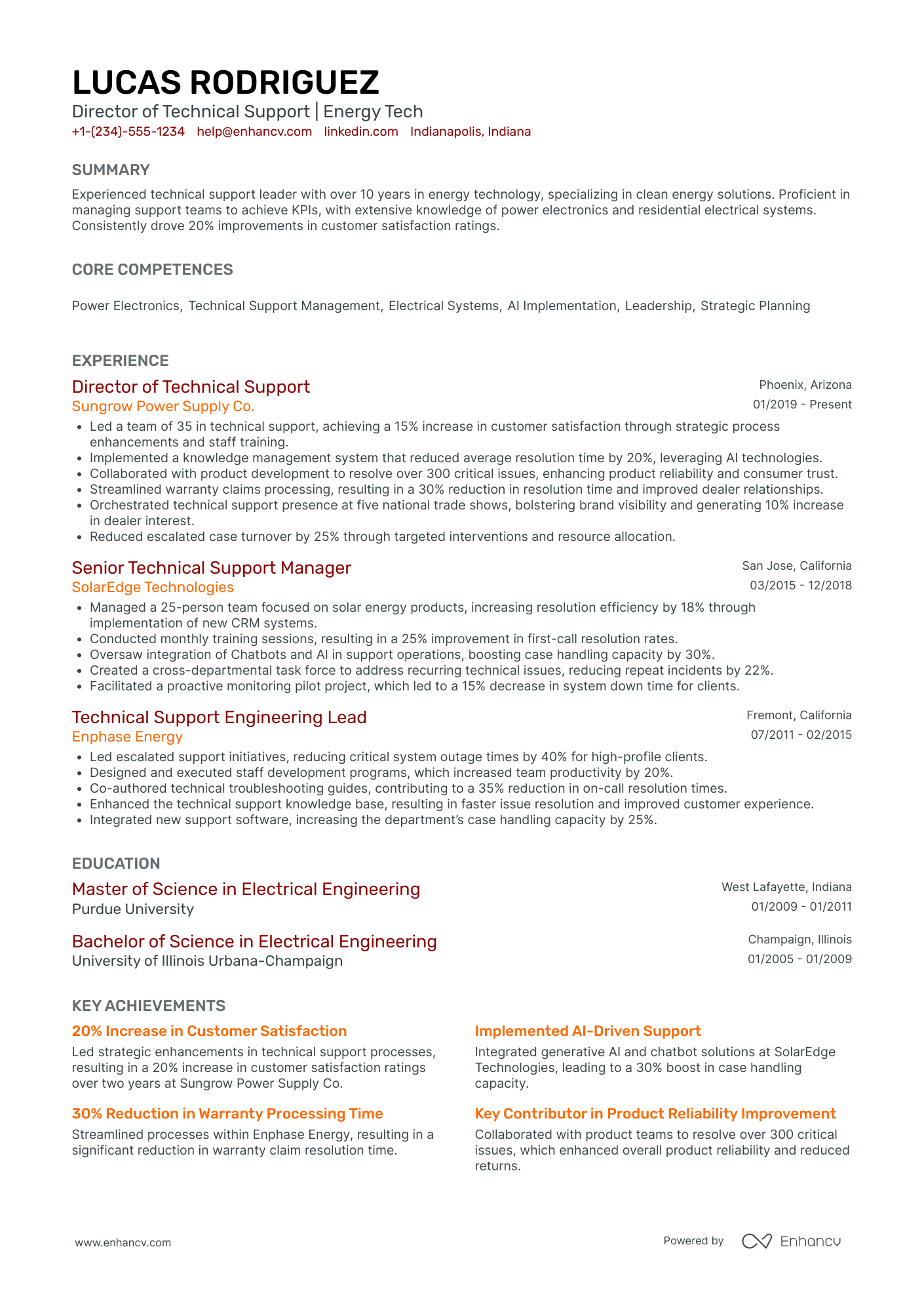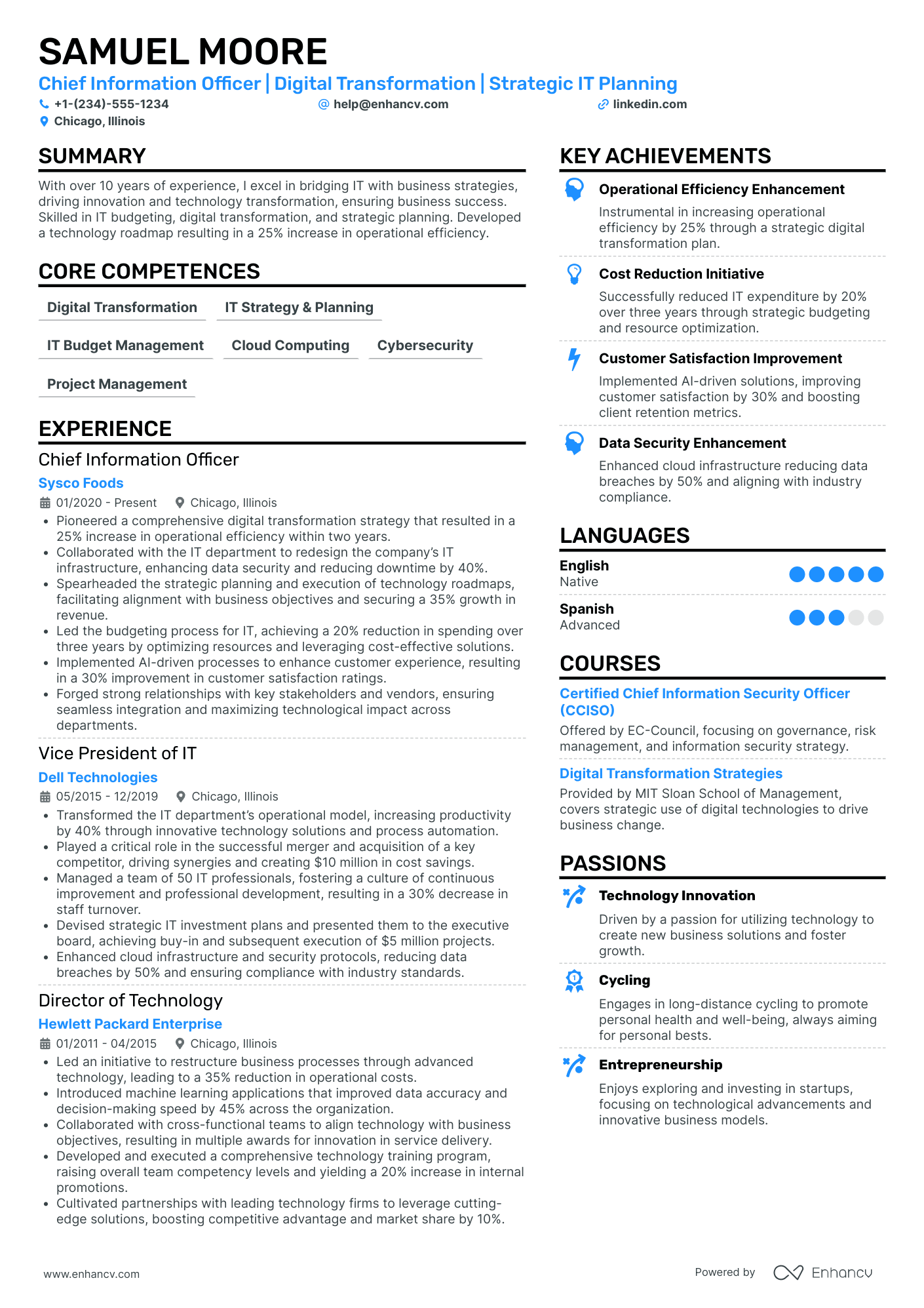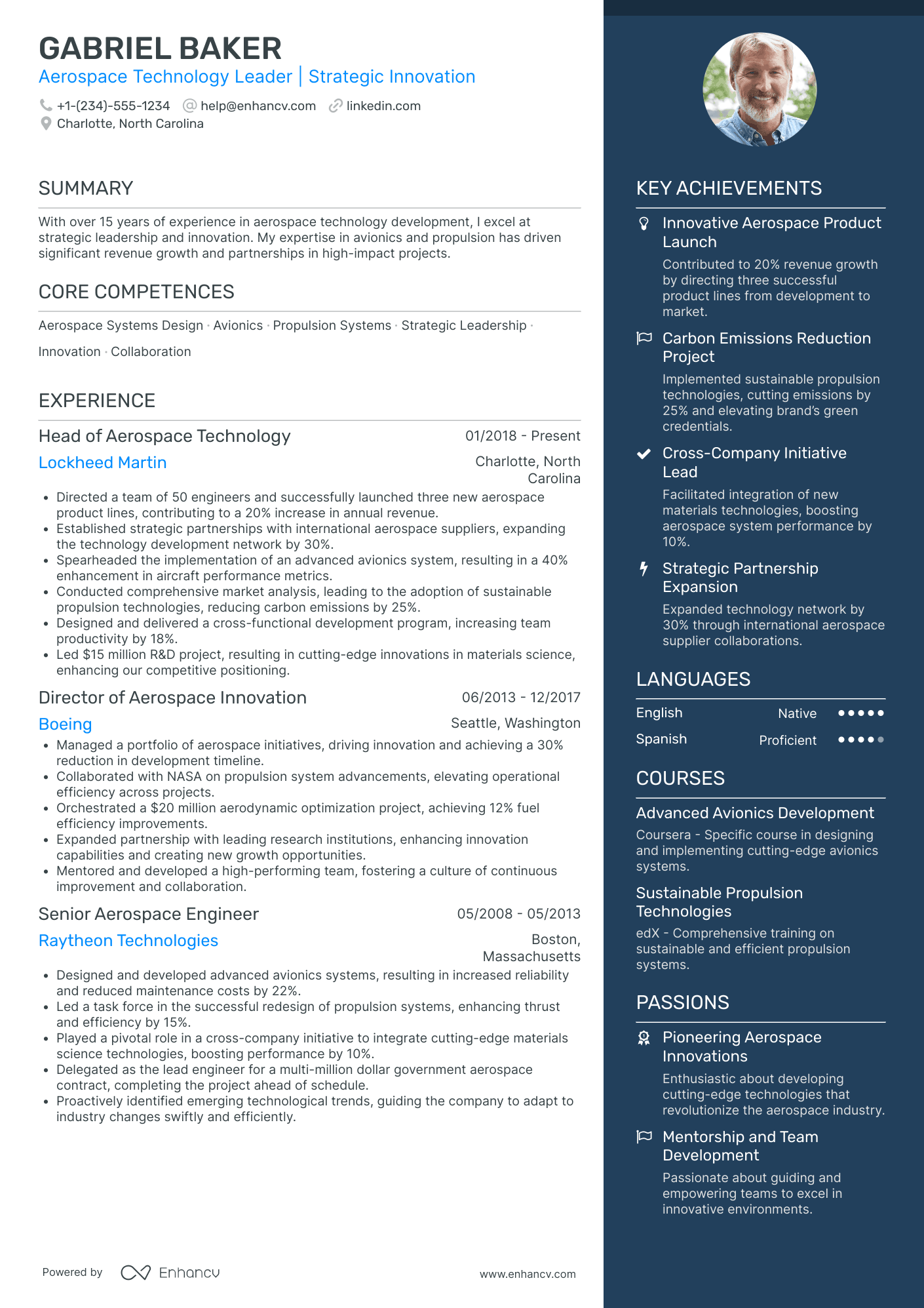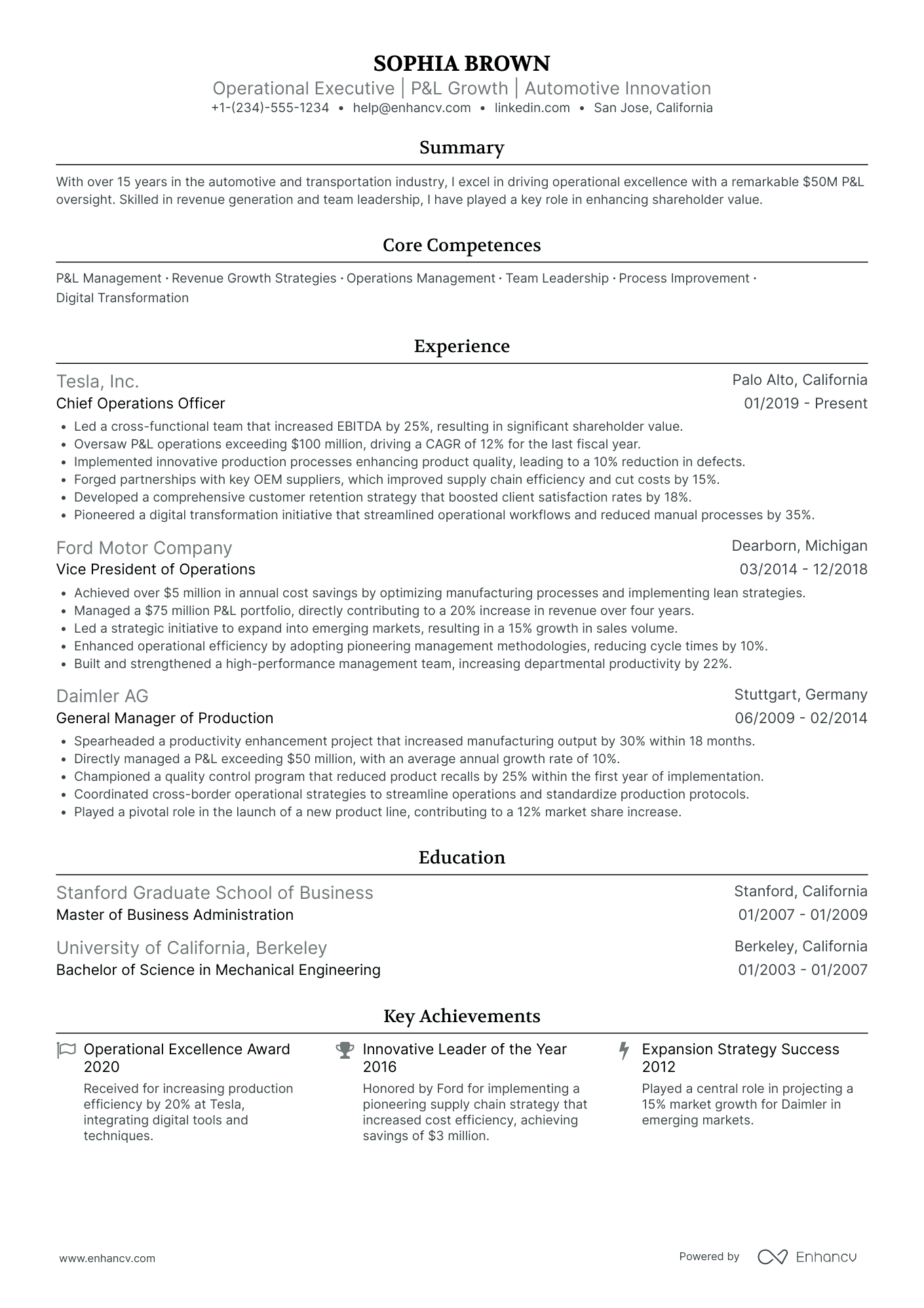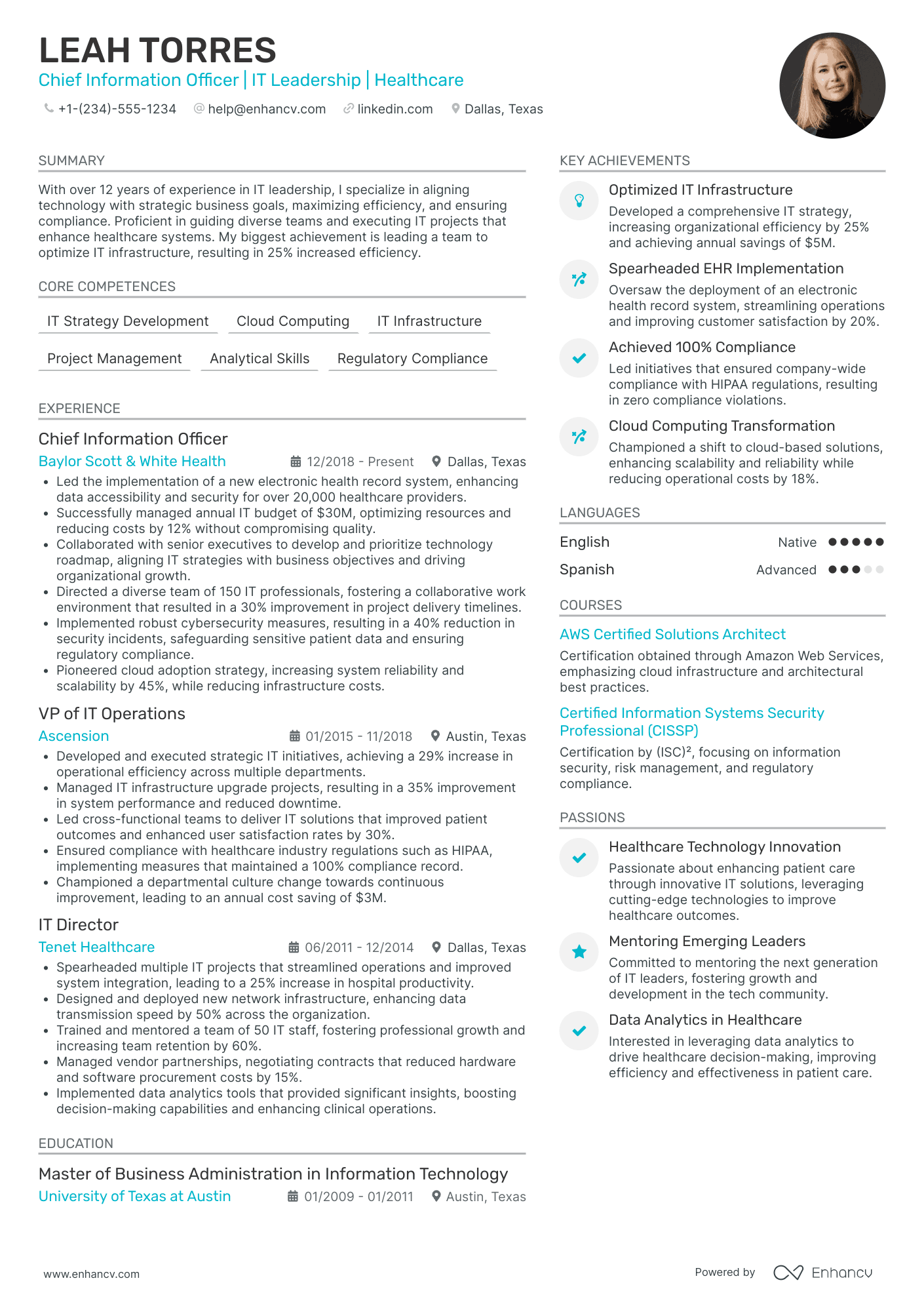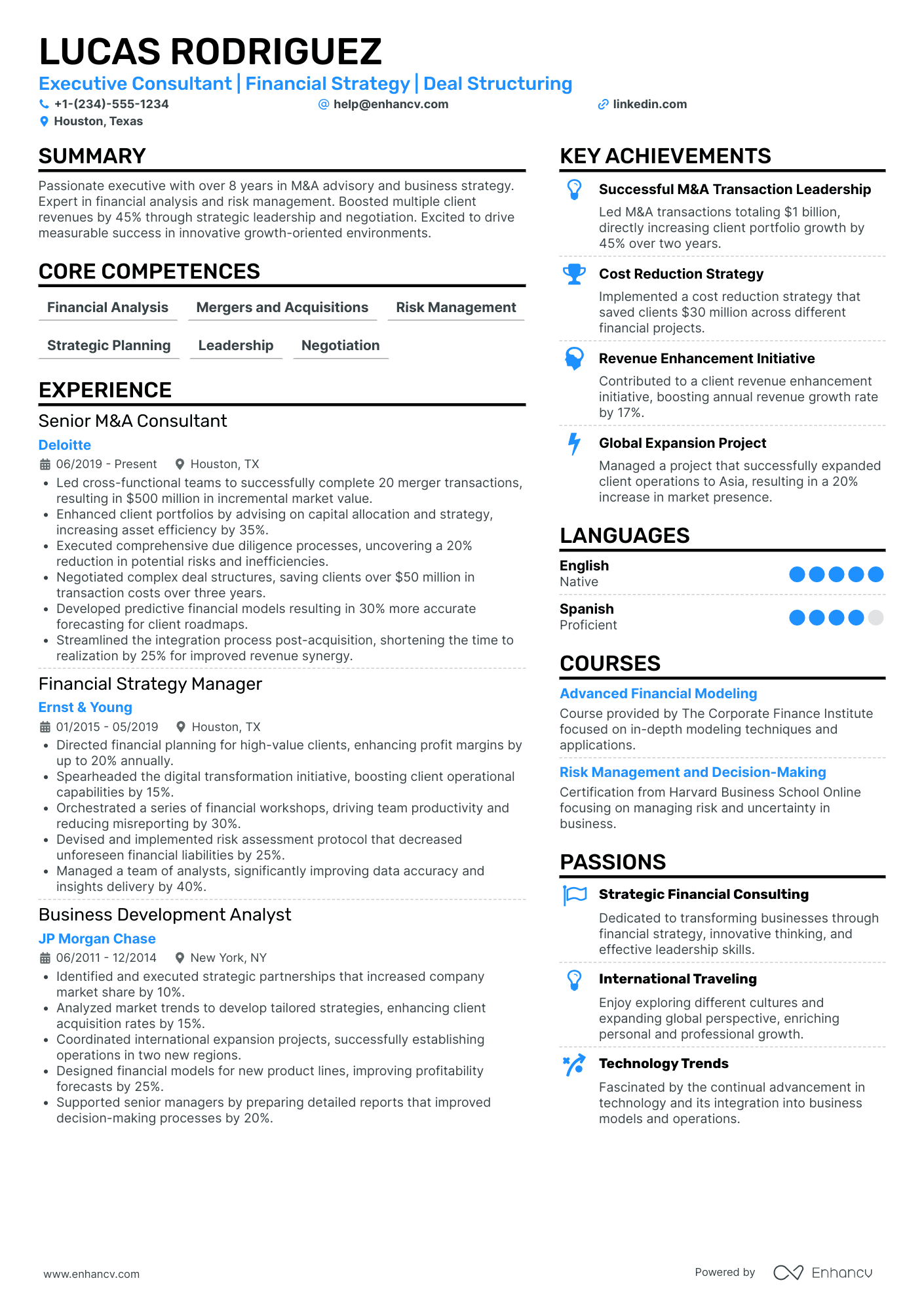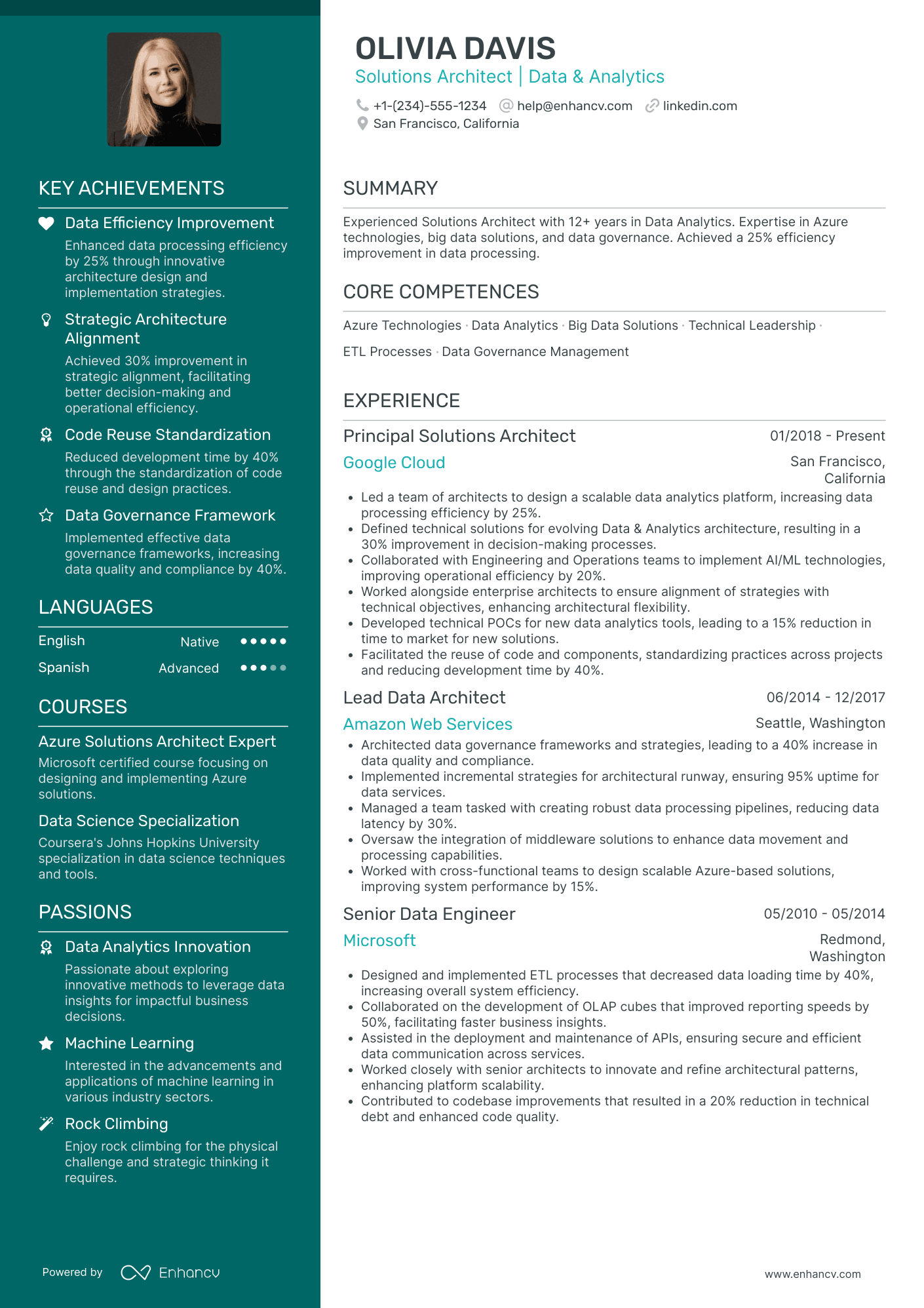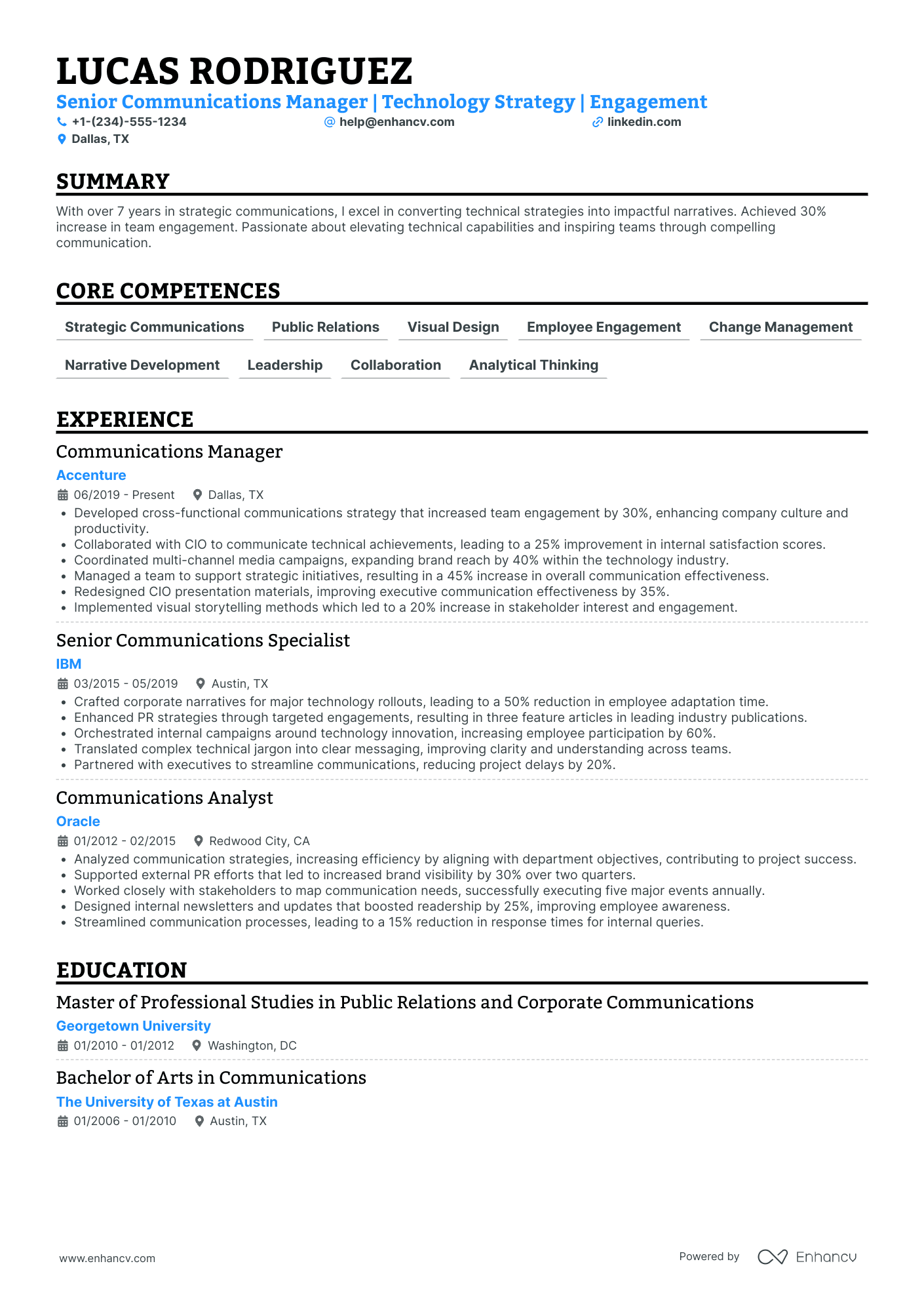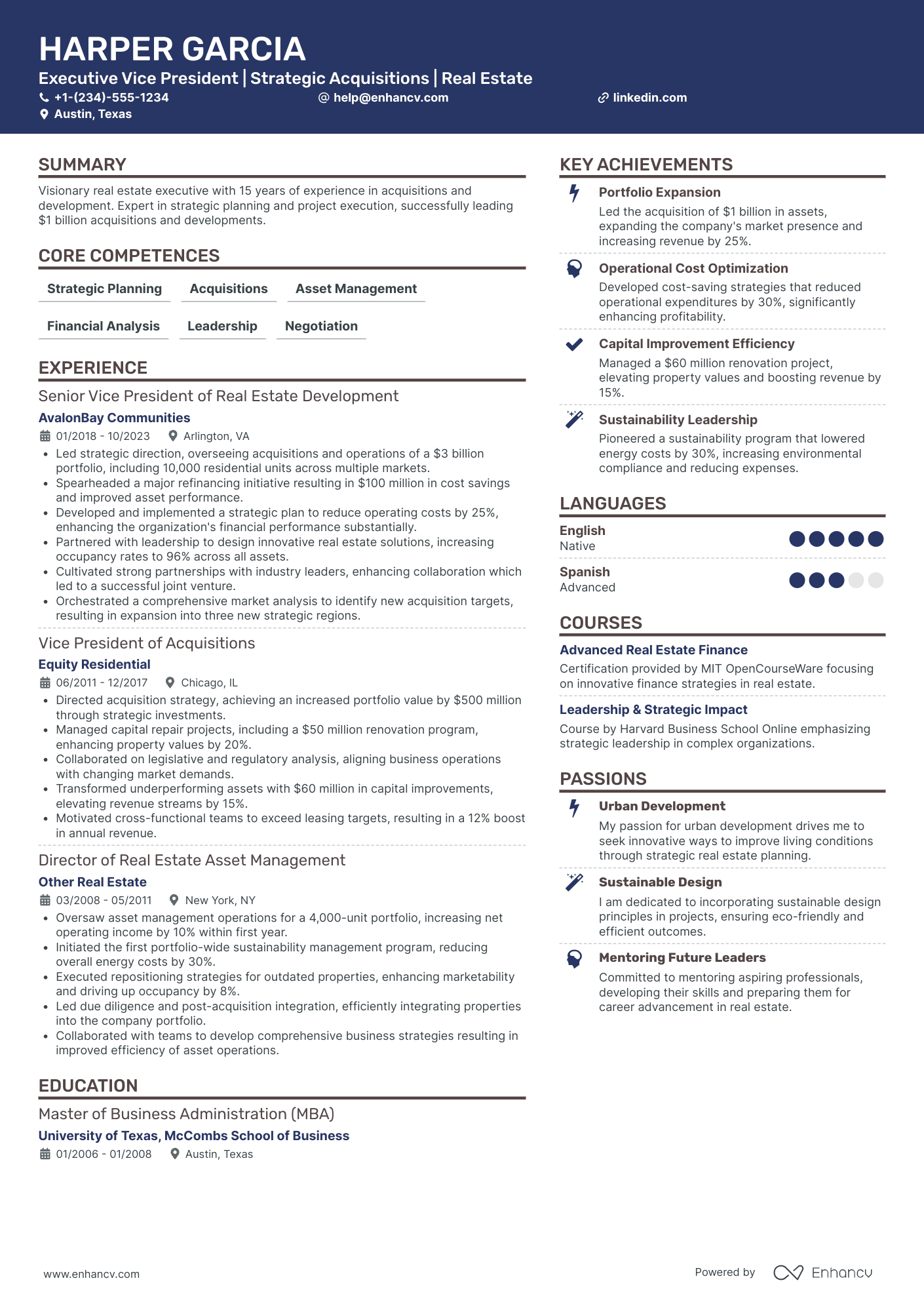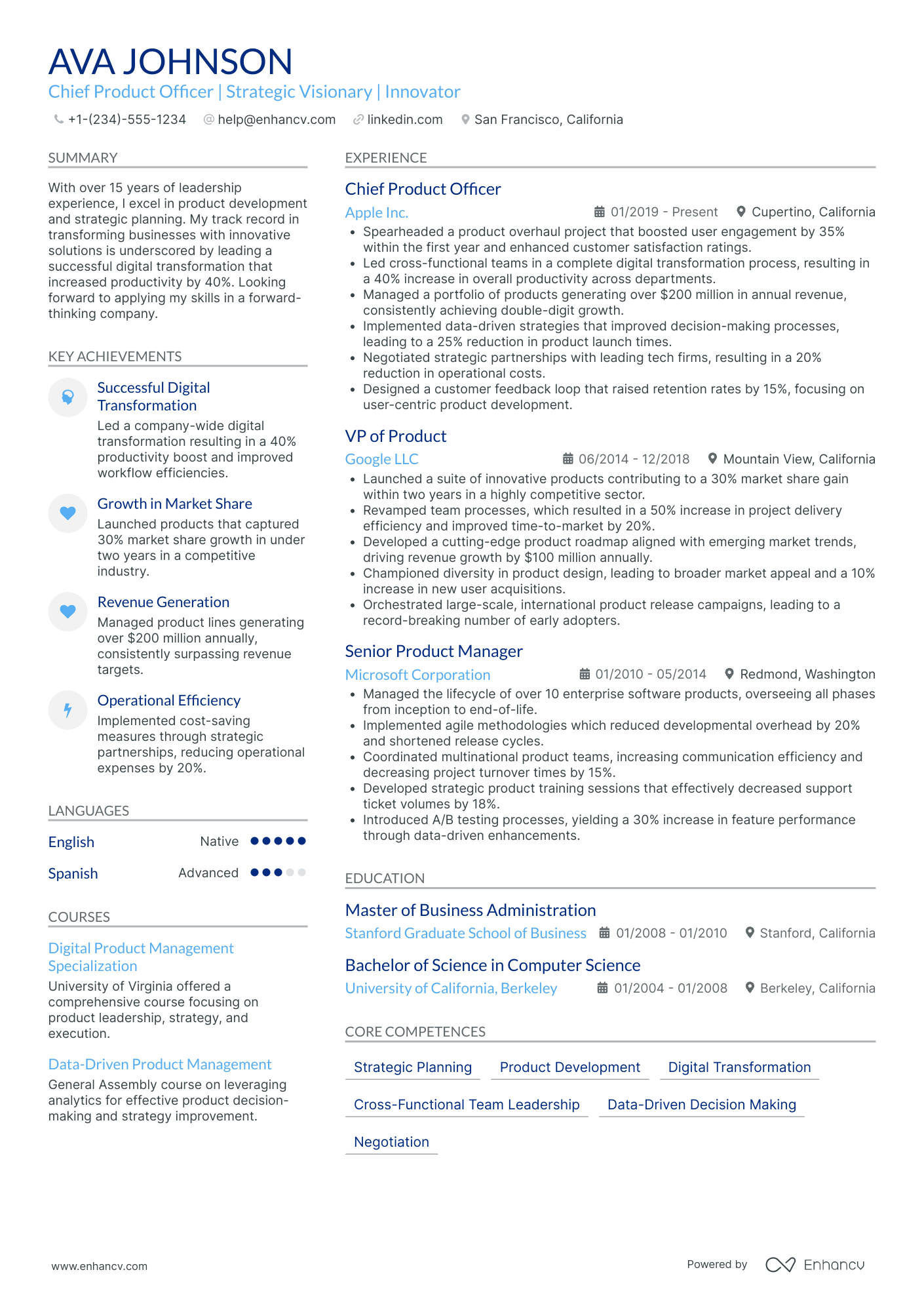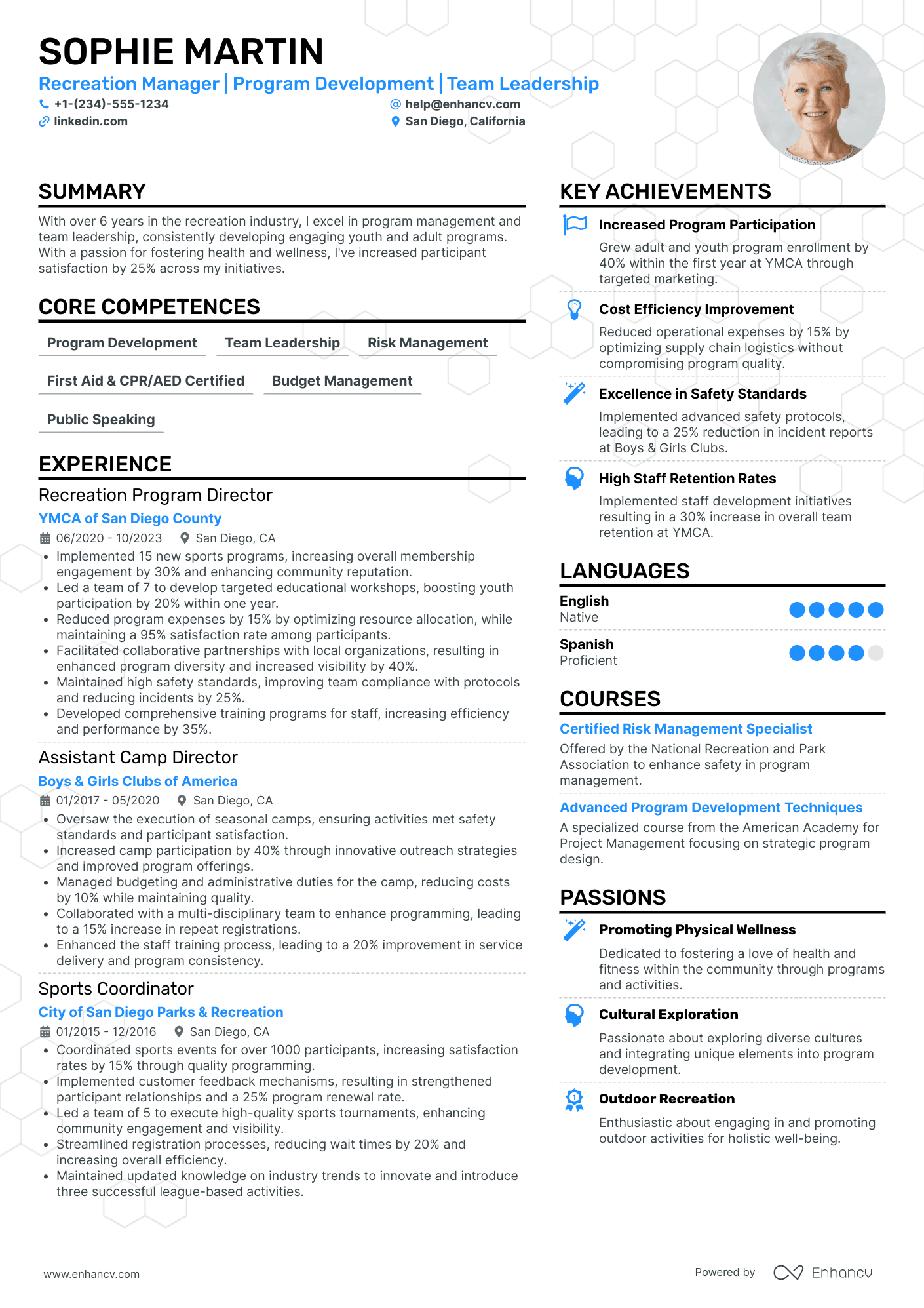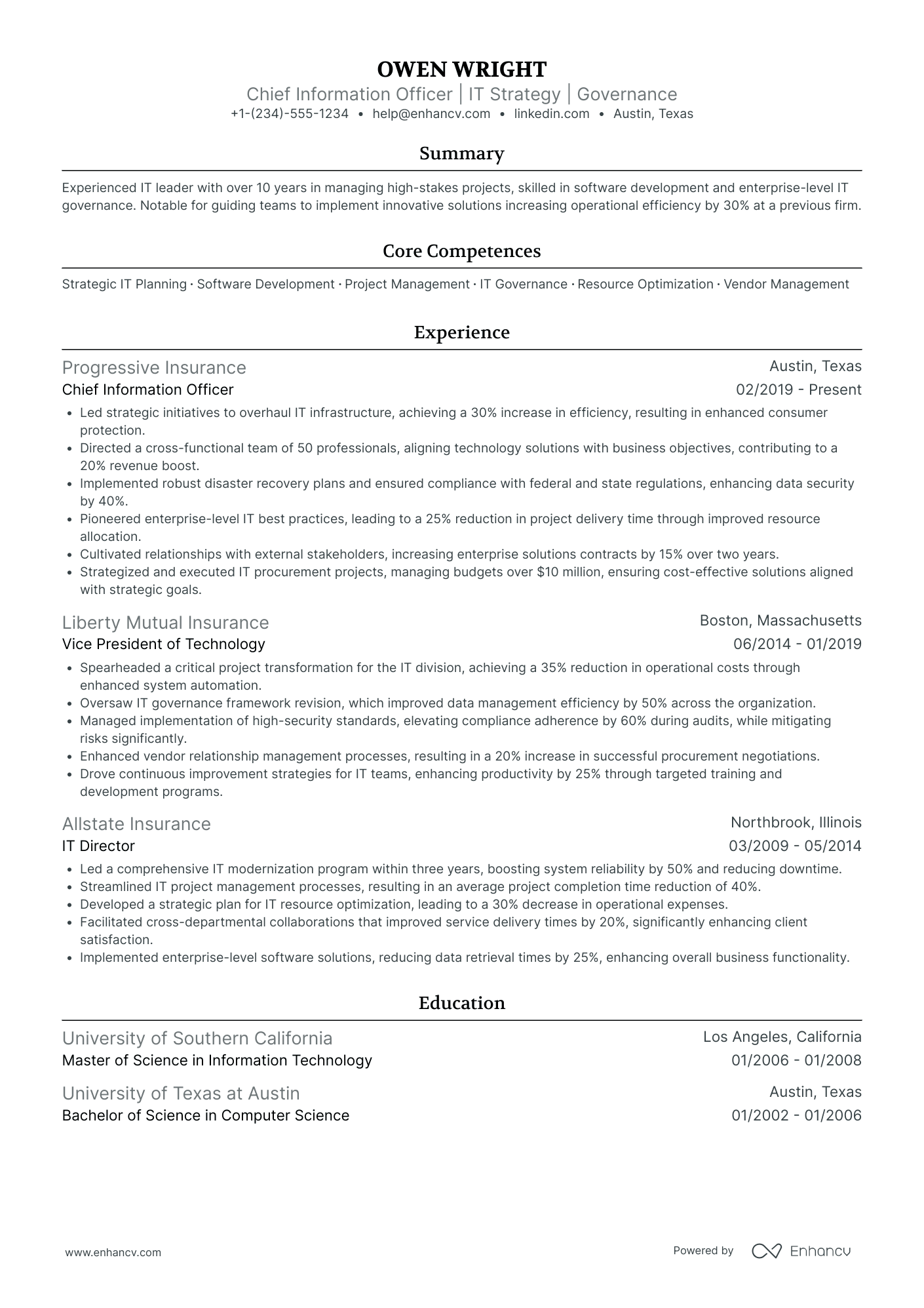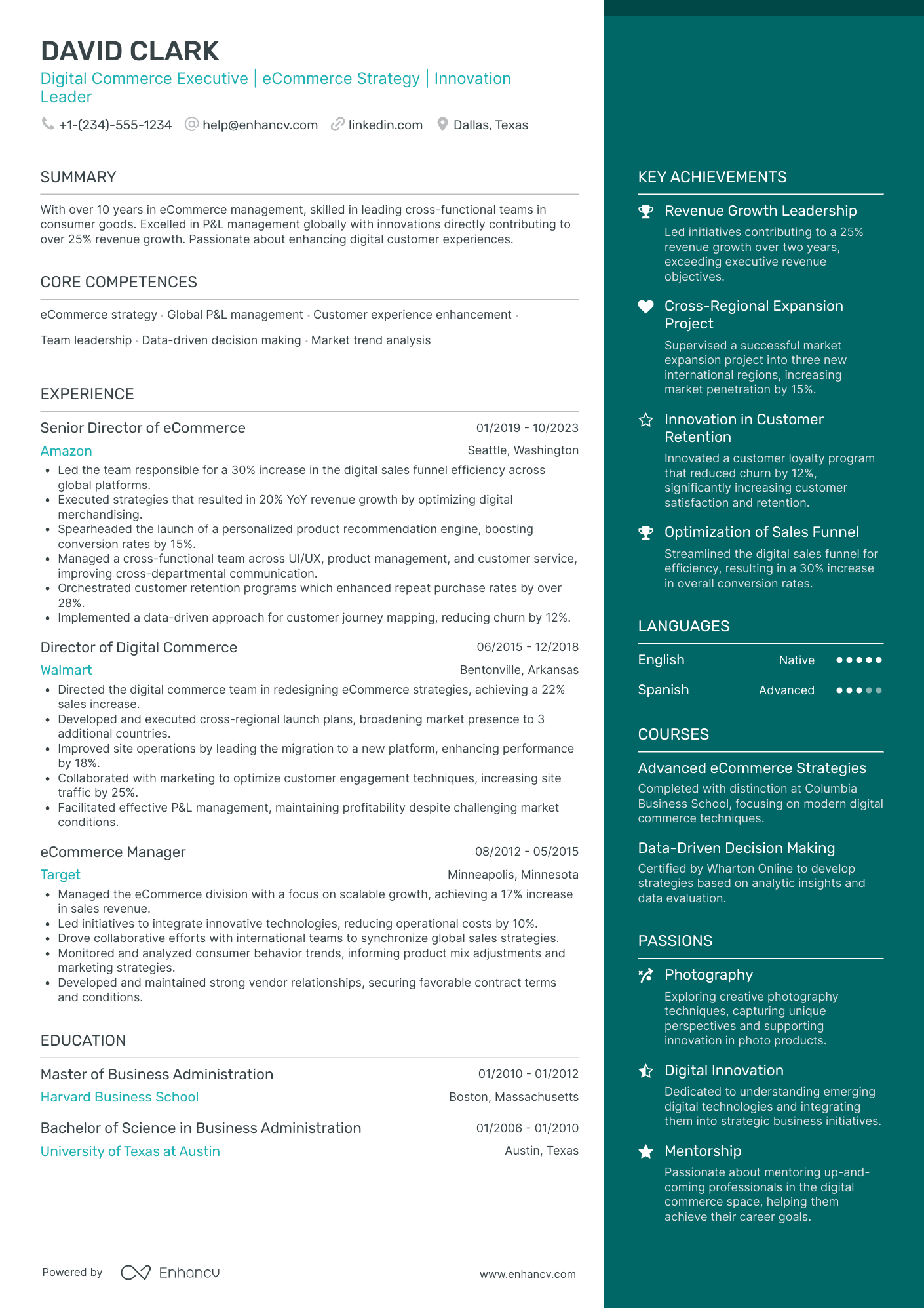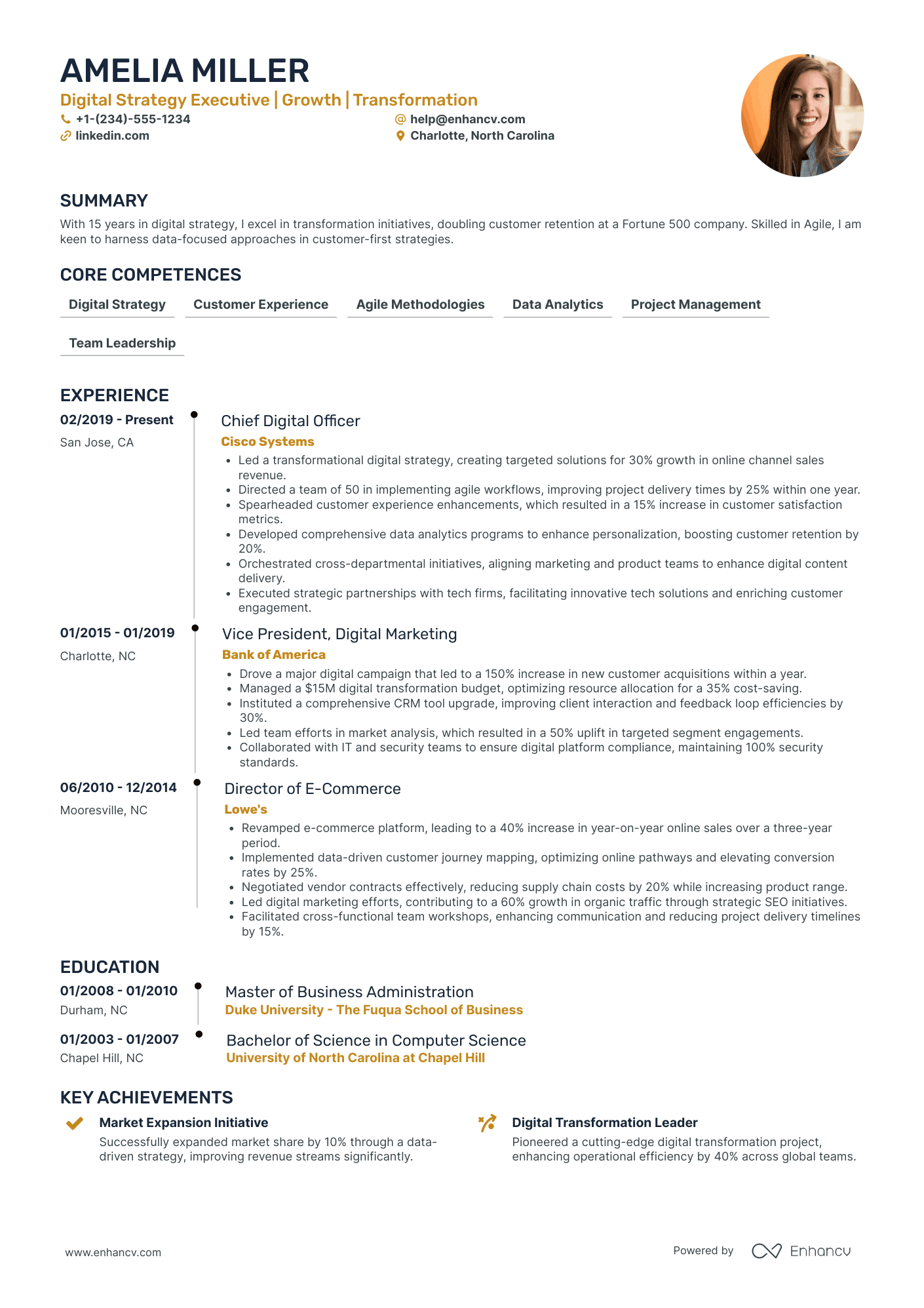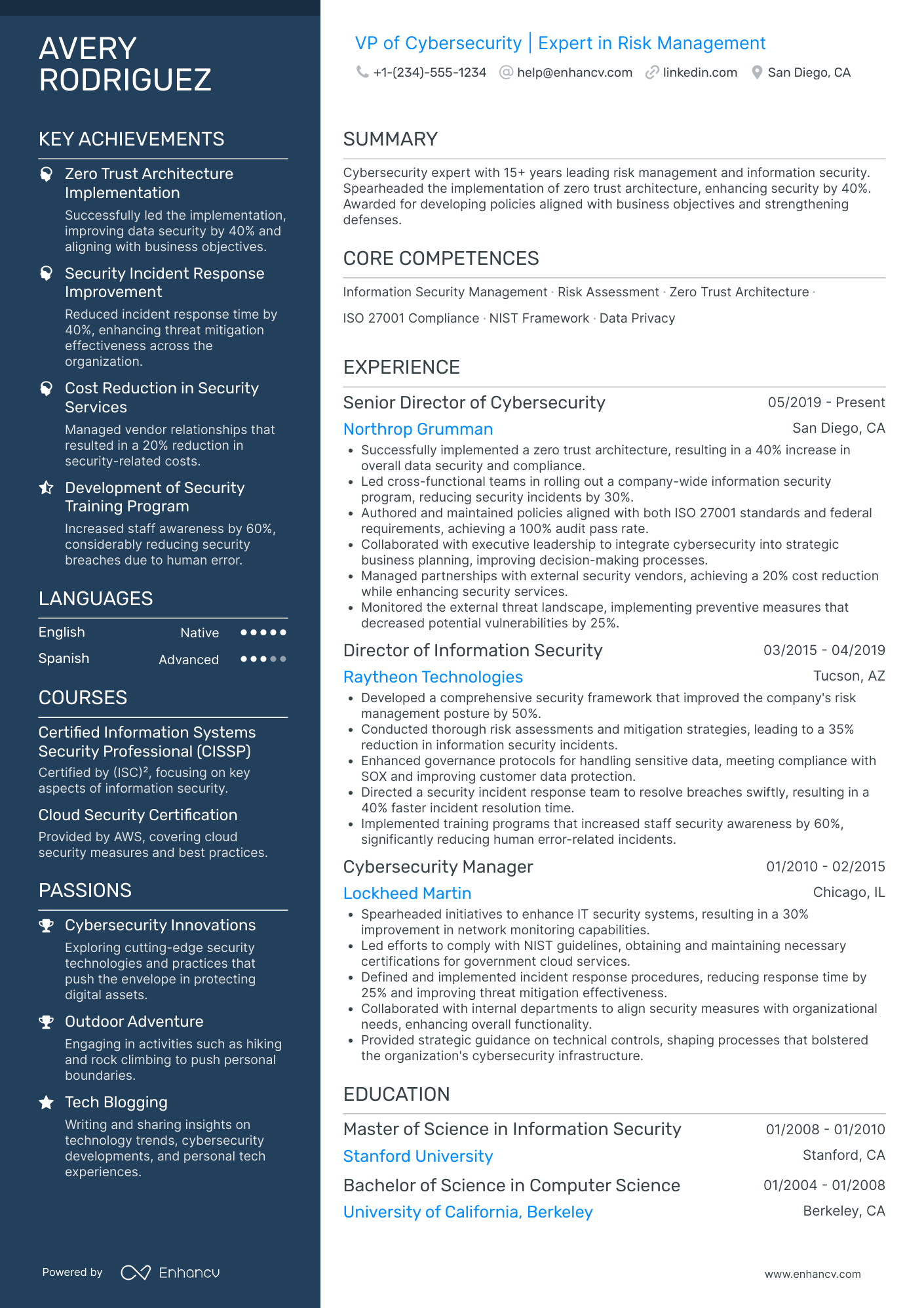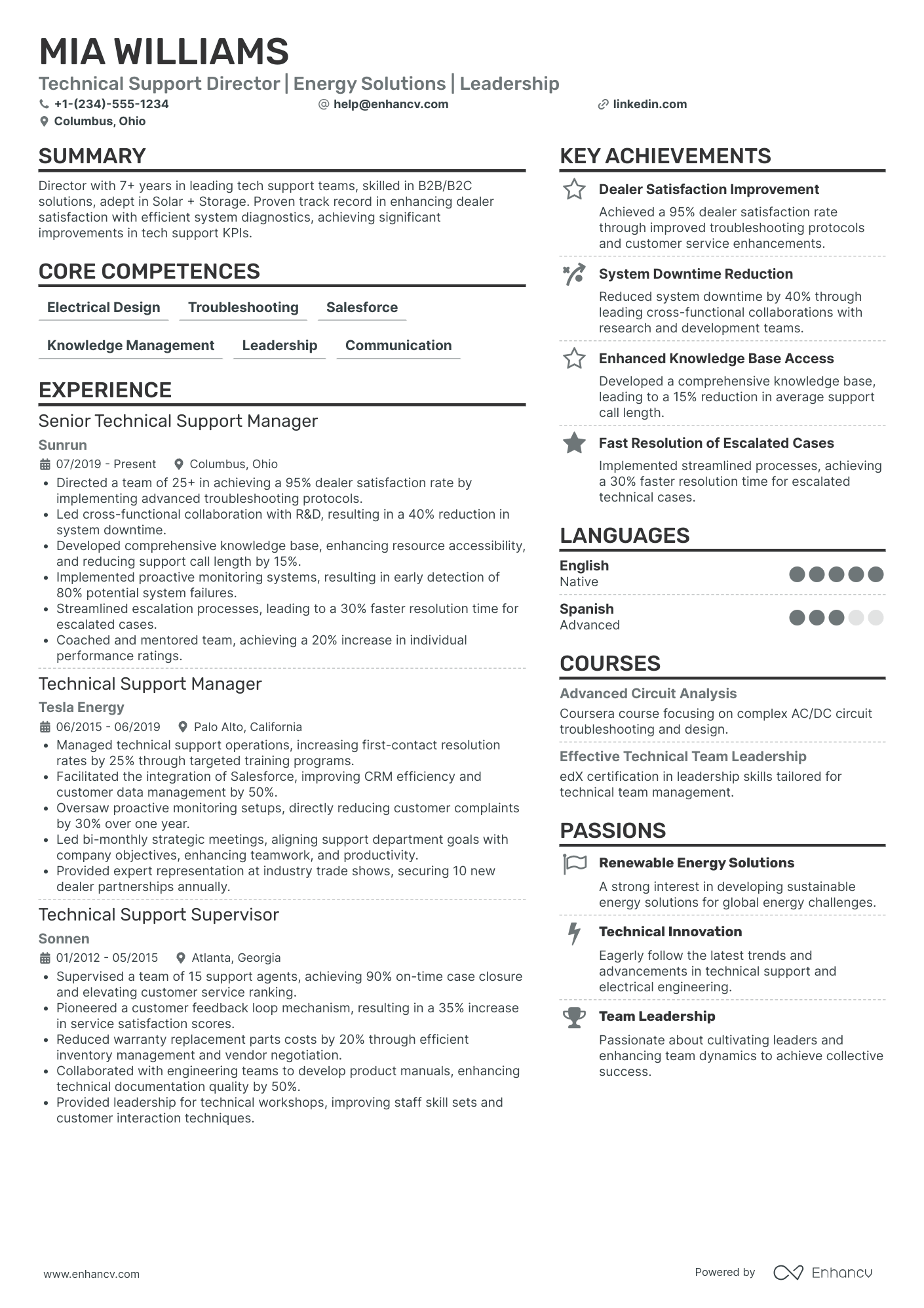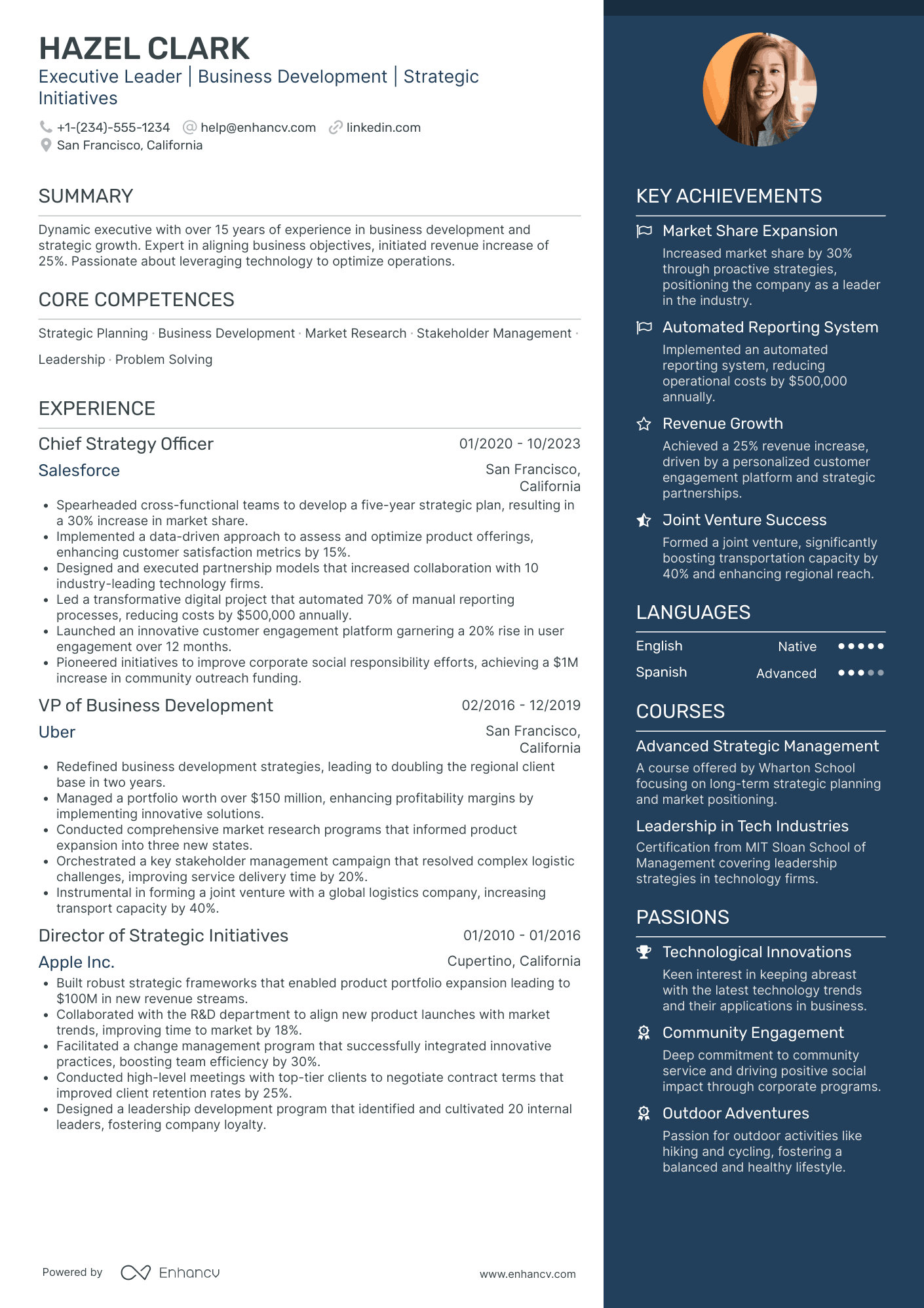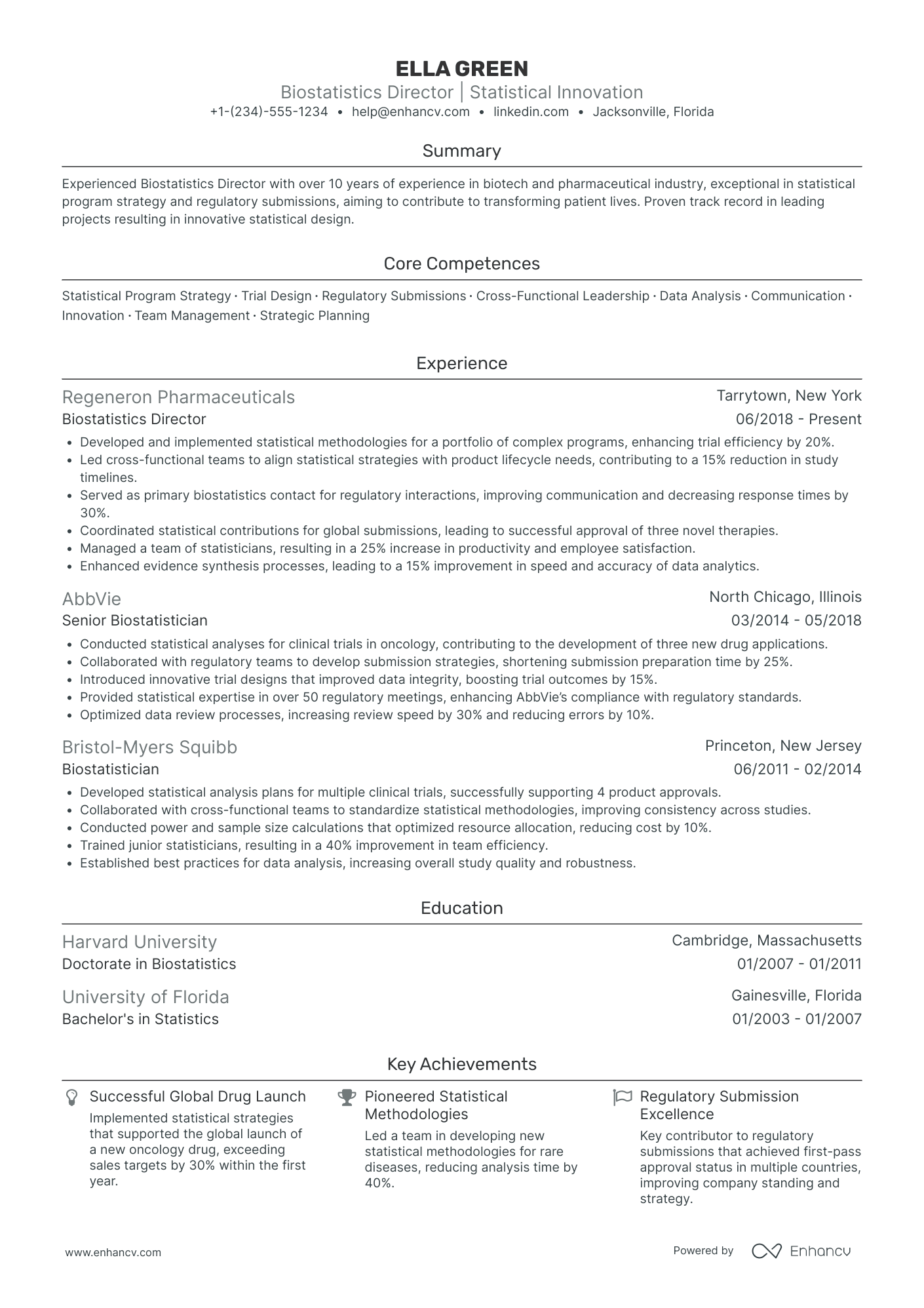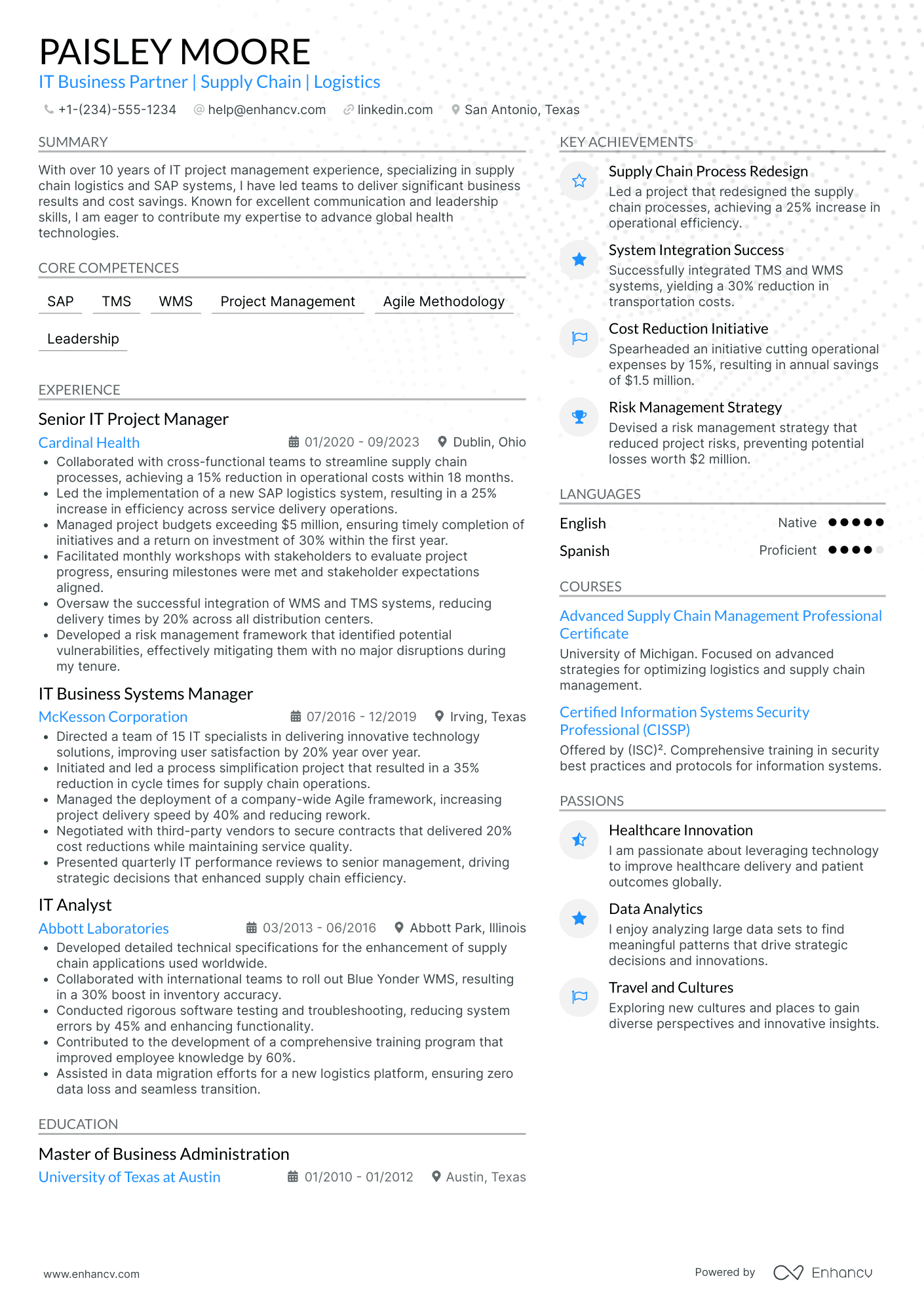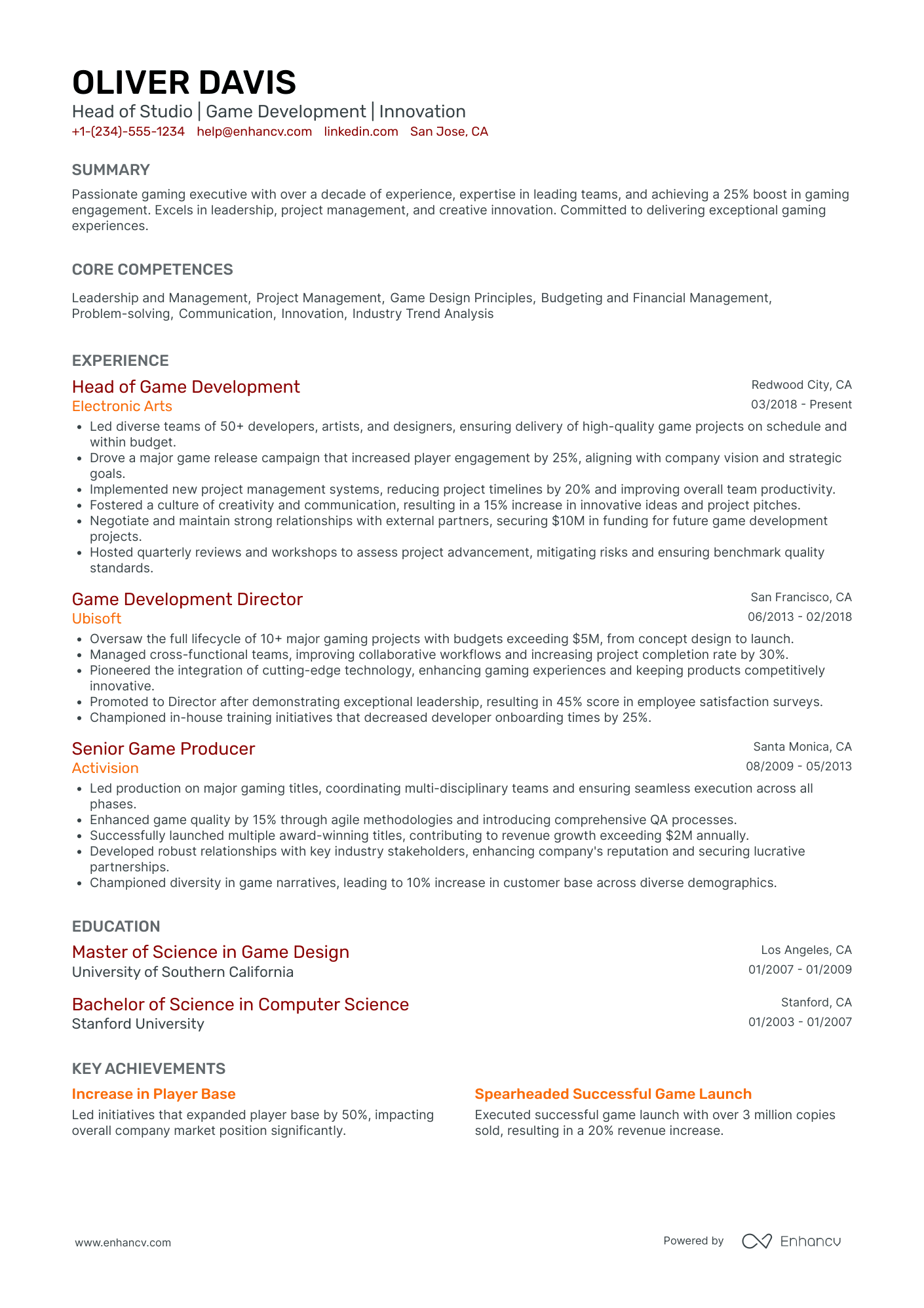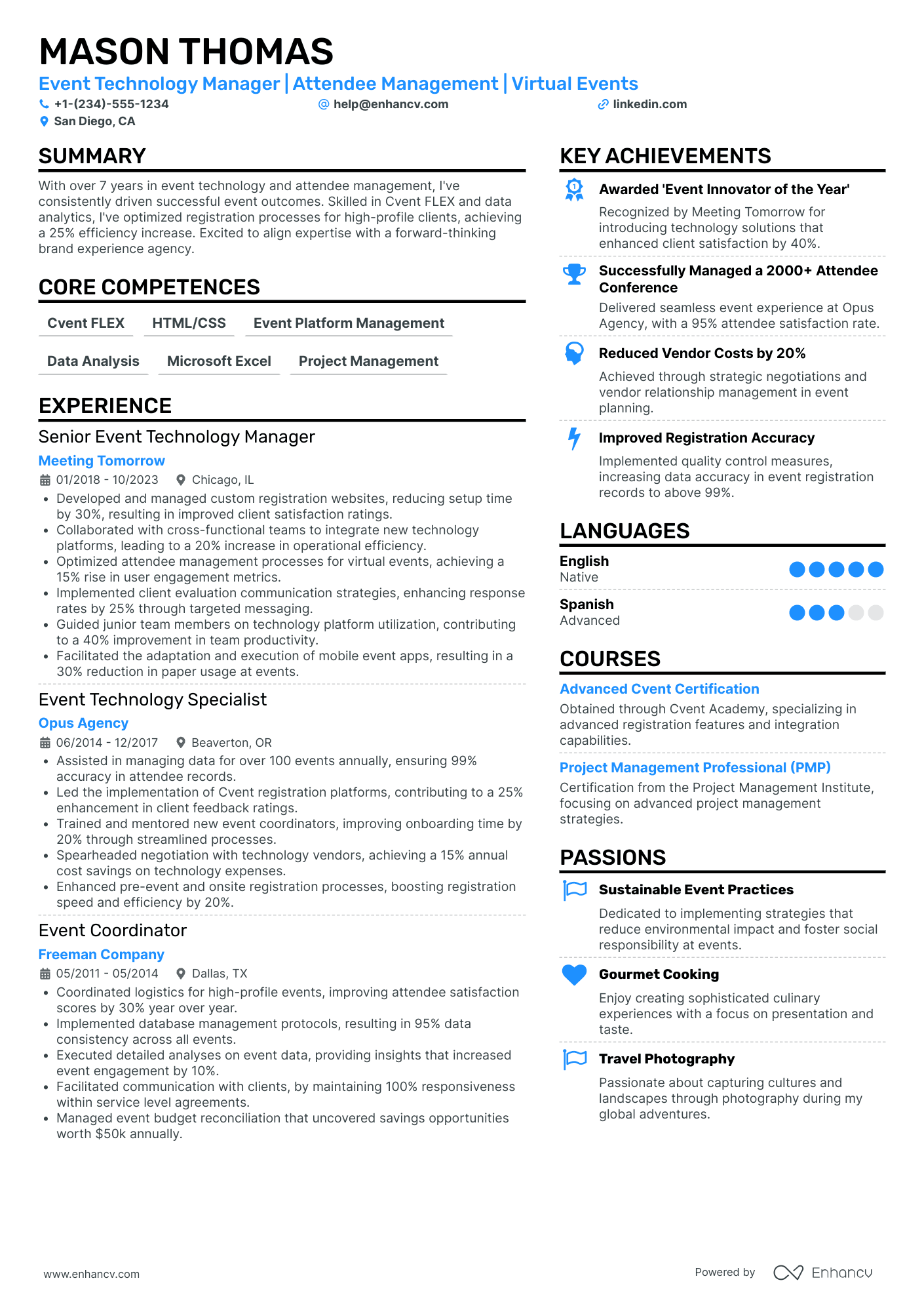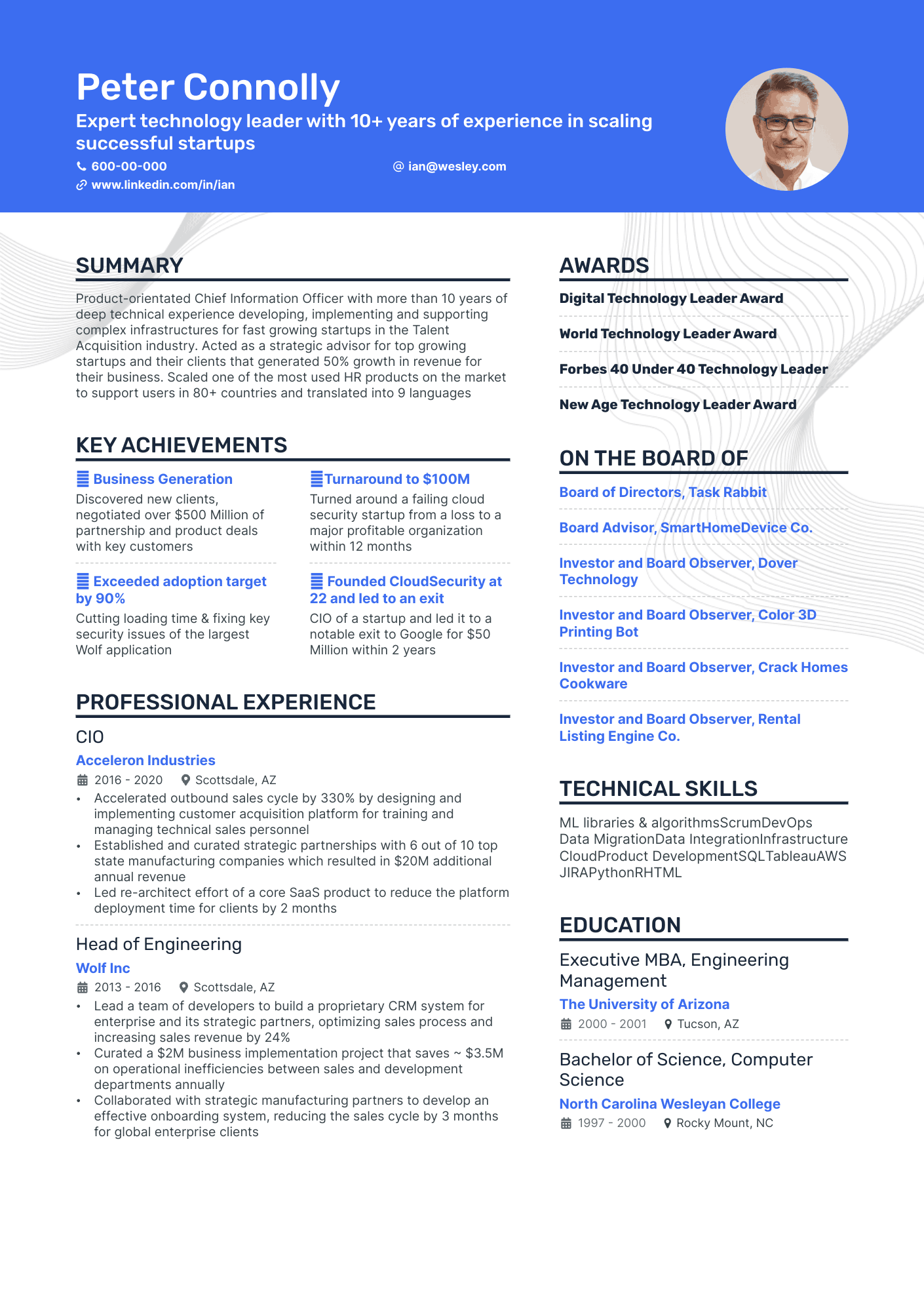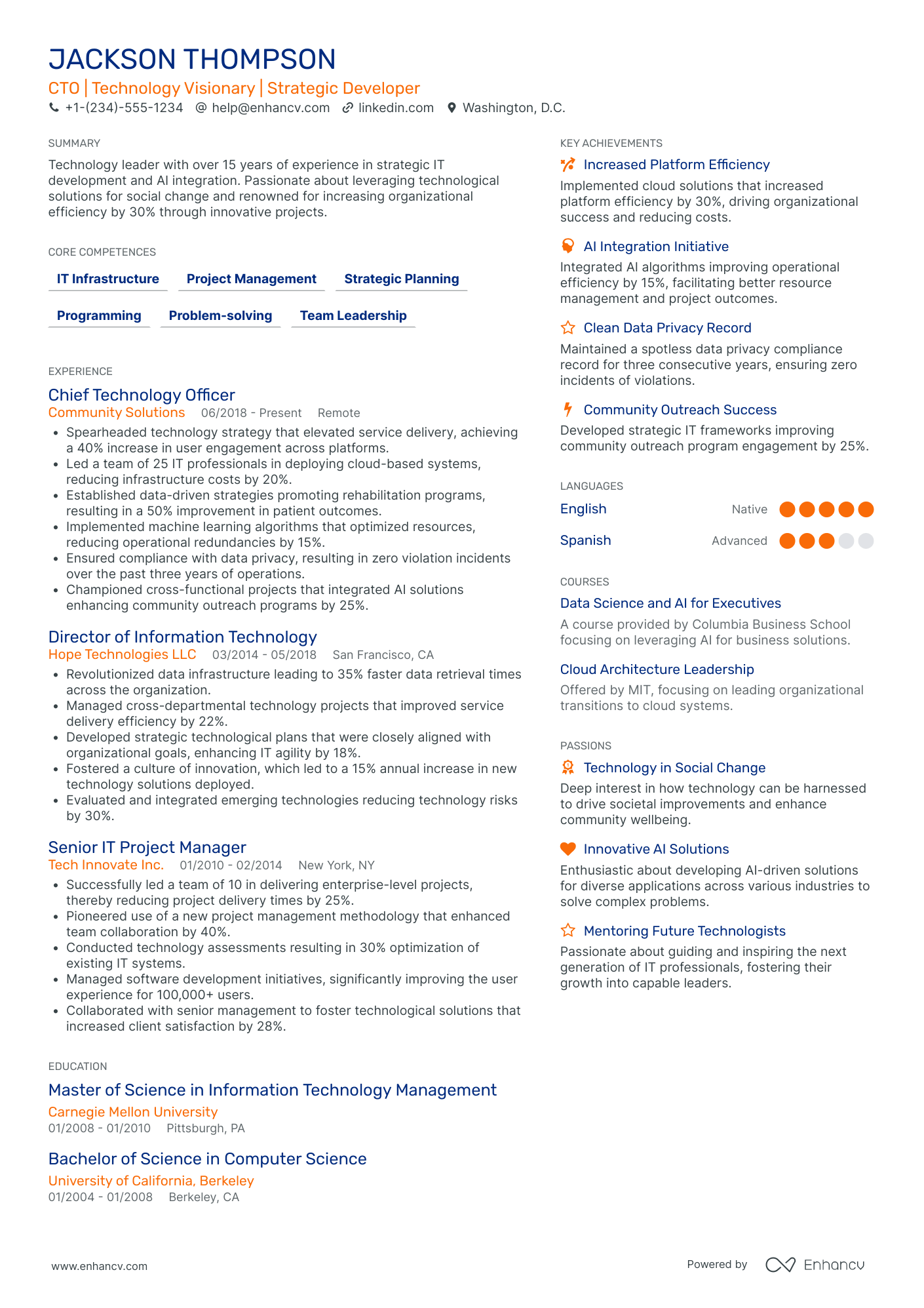As a CIO, you have your fingers on the pulse of technological innovation, doing everything you can to allow your company to thrive with cutting-edge advances in computer technology. But even when you’re leading with digital transformation initiatives, you’re still motivating and managing your team of technicians and IT professionals and providing them with a big-picture mindset of what winning looks like.
You do your best to keep pace with innovation in the IT field, but your current resume doesn’t showcase your commitment to learning and developing new skills. At Ehancv, we love showing people how to brag about their skills and experience through their resume. In this article, we have CIO resume examples, and topics to help you create an eye-catching resume, including:
- How to mold your resume experience section to highlight your strengths.
- Strategies to make your resume shine by highlighting your skills and expertise.
- Tips on how to quantify the impact on your resume.
Chief information officer (cio) resume example
Here’s what makes Peter’s resume outstanding for a Chief Information Officer position::
- Track Record of Success: Highlights past achievements that display the ability to generate significant revenue growth for businesses. Examples from Peter's resume include negotiating over $500 Million of partnership and product deals, turning around a failing startup to profitability within 12 months, and leading a startup to a $50 Million exit to Google.
- Technical Expertise and Leadership: Emphasizes experience scaling technology infrastructures, especially in the specific industry of interest. Peter's work in developing and supporting complex infrastructures for fast-growing startups in the Talent Acquisition industry is a crucial point, as is his leadership in roles like CIO and Head of Engineering.
- Broad Technical Skill Set: Mentions specific technical skills that align with the demands of a CIO role. Here, Peter's skills in DevOps, Data Migration, Infrastructure, Cloud, and Product Development are particularly relevant for a technology leadership position.
- Board and Advisory Roles: Showcases roles and responsibilities that indicate a higher level of strategic influence and trust in the industry. Peter's positions on the Board of Directors and as an Advisor or Board Observer for various technology companies illustrate his influence and expertise in the tech sector.
How to format a chief information officer (cio) resume
Whether it’s interacting with shareholders who possess little technical understanding or equipping your team with the data they need to thrive, information can most easily be shared in an easy-to-read format. This is especially true for your resume, as the best resumes convey complex information using a format that is both easy to scan and understand.
Just like adjusting the code you write, making small incremental changes can make your resume more reader-friendly. By using columns, you can separate important information and aid in readability. This can be a great way to point the reader’s eyes towards your important achievements and skills.
Below, you’ll find a list of helpful tips for formatting your resume:
- Reverse chronological resume format: The reverse chronological format involves listing your most recent experience first. Most employers are looking for your career trajectory, showing both where you started out and how you’ve worked to achieve your career goals. By listing your most recent experience first, you can show how far you’ve come in your career.
- Header, contact info, photo: Your header is a great place to include all of your important contact information (phone number, email address, personal website, LinkedIn profile, etc.). You may wish to include a photograph of yourself, but it’s not required.
- How many pages: To reach the pinnacle of success in the IT field as a CIO, you’ve likely held several jobs in the field with a myriad of unique experiences and achievements. It's hard to contain all of this information in a one-page resume. It can be downright impossible to cut out some of your most important roles. For those in senior management, you may wish to extend your resume past one page. However, one page is just fine as well.
- PDF or Word Format: PDF is now the reigning file type to use for your resume, as it is easier to send in an email, and photos won’t shift around. Once you create a PDF file know that it will work out.
Is your resume good enough?
Drop your resume here or choose a file. PDF & DOCX only. Max 2MB file size.
The top sections on a Chief Information Officer (CIO) resume:
- An "Executive Summary" provides a concise overview of your expertise and value.
- "Strategic IT Initiatives" highlight your ability to drive business growth through technology.
- "Technical Expertise" underlines your familiarity with the latest technologies and platforms.
- "Leadership and Team Development" showcases your capability in managing and nurturing teams.
- "Digital Transformation Efforts" reflects your experience in steering businesses through digital shifts.
What recruiters want to see on your resume:
- Proven experience in leading IT strategy and digital transformation initiatives, demonstrating alignment with business goals.
- Expertise in modern IT governance frameworks, risk management, and cybersecurity best practices.
- Track record of successful budget management and vendor negotiations for complex IT projects and infrastructure investments.
- Demonstrated leadership skills in managing diverse technical teams, fostering innovation, and promoting a culture of continuous improvement.
- Knowledge of emerging technologies and trends, including cloud computing, AI, IoT, and their potential business applications.
How to write your chief information officer (cio) resume experience
If you’re interested in writing a CIO resume, then you’re going to have to start with your experience section. Considered to be the most important section on a resume, your experience section allows you to showcase your most important achievements and unique experiences throughout your career.
When writing a chief information officer resume experience section, it’s important to provide real-world data points, percentages, and dollar figures to showcase to back up all the claims about your previous experience.
As a chief information officer, you no doubt have a lot of experience under your belt. The most important thing for your experience section is to make sure that it is tailored to the job that you’re applying for. Also, only include relevant experience for the job that you’re applying for. For example, if you were the manager of a fast food place in high school, that is going to have little bearing on a CIO’s role. Instead, just leave that off your resume.
CIO resume experience samples
- •Reorganized all members of the IT team focusing on strategies to better increase efficiency.
- •Helped the DevOps team to deliver a new infrastructure environment within 150 days, benefiting over 5000+ customers.
- •Developed a one-year roadmap which aligned the IT department with the shareholders, management, and board of directors.
- •Established and maintained a robust cybersecurity framework, reducing the organization's exposure to cyber threats.
How does this resume experience section fall flat?
The major issue with this experience section is that it is very vague. It doesn’t delve into the strategies that the person took to implement change in their previous company, nor does it give real-world, quantifiable data to back it up. In addition, it doesn’t use robust verbs and words to build the case that they had a major impact in a previous role. For example, this example uses the word “helped”, which implies that they took a backseat and allowed the DevOps team to do most of the work. Instead, the author should’ve used more active action verbs to showcase that they’ve had a major impact.
- •Structured and reorganized IT teams of 100+ people, creating a more integrated work stream on all technology projects.
- •Spearheaded an initiative with the DevOps team to deliver a new infrastructure environment within 150 days, benefiting over 5000+ customers.
- •Developed a one-year roadmap which aligned the IT department with the shareholders, management, and board of directors, resulting in a 20% increase in operational efficiency.
- •Established and maintained a robust cybersecurity framework, reducing the organization's exposure to cyber threats by 30% through the implementation of advanced security measures and employee training programs.
What works in this section?
Scattered throughout this resume experience section is real data on which a hiring manager can see and understand the role that the applicant has had. We see the exact number of people that they led during their tenure, and we also learn that this one-year roadmap led to an increase of 20% in operational efficiency. These real percentages lend credence to the author’s competency.
In fact, during an interview, you may be asked to give more information on facts and figures that you mentioned in your resume. Laying down this foundation of competency can give you a significant edge against other candidates.
How to quantify the impact on your resume
When the CEO comes to you and asks for actual information on the project you’re working on, you’ll likely have a presentation ready that highlights time frames, dollar figures, and expected revenue. All of this quantifiable data directly shows how the project you’re working on will work towards the goals of the company to its success. The same goes for the claims that you make on your resume about your experience.
Having quantifiable data on your resume can help to bolster all the claims that you make. It’s allowing a potential hiring manager to do their research and check up on your success.
It is important to include the context behind the claims that you make. Don’t just include data figures and percentages with nothing explaining them. Instead, provide the background details on how you achieved success. This not only quantifies your achievements but also helps potential employers understand the impact of your contributions to the organization. Ensure that the percentages align with the priorities and expectations of the specific CIO role you are applying for.
Percentages
Whether it’s an increase in efficiency or how you streamlined the workload of your team, including percentage points on your resume can help to lend credibility. Some percentages you may wish to highlight on your resume include:
- Operational Efficiency
- Cost Savings
- Cybersecurity Improvement
- Revenue Growth or Cost Avoidance
- Employee Satisfaction
- Project Success
- System Uptime or Downtime Reduction:
- Technology Adoption
Dollar figures
A dollar figure amount is a substantial data point to include on your resume because it shows how much revenue was generated through the work that you did. If you had a fairly successful product launch that generated significant revenue for your previous employer, include the precise dollar amounts created by sales. Some dollar amounts you should highlight include:
- Cost Savings
- Revenue Generation
- Return on Investment (ROI)
- Budget Management
- Contract Negotiations
- Project Budget Adherence
- Employee Productivity
- Risk Mitigation
Other Data Figures
Besides percentages and dollar amounts, a CIO resume can benefit from including various data figures that highlight your achievements and showcase your impact on the organization. Consider incorporating the following data:
- Project Metrics
- Technology Metrics
- Security Metrics
- Operational Metrics
- Strategic Planning Metrics
- Team Metrics
- User Engagement Metrics
- Customer Metrics
- Regulatory Compliance Metrics
- Technology Adoption Metrics
Example of a good quality impact section
- Include IT project budget figures: Revealing the scale of budgets managed illustrates financial acumen and trustworthiness with significant funds.
- Detail cost savings from IT initiatives: This shows the ability to drive efficiency and highlights a focus on cost optimization.
- Highlight percentage uptime or system availability: Showcasing high percentages shows a commitment to business continuity and minimal operational disruptions.
- Quantify the scale of IT infrastructure managed: Providing numbers on servers, databases, or user endpoints managed offers insight into the complexity and scale of operations overseen.
- Specify the number of direct and indirect reports: Displaying team size gives a sense of leadership scale and people management capabilities.
- Mention the percentage reduction in security incidents: Demonstrating improvements in security showcases a proactive stance on risk management and data protection.
- List the number of successful IT projects delivered on time and on budget: This evidences project management skills and the ability to meet business objectives.
- Quantify improvements in system performance or user satisfaction scores: Presenting growth or prominent figures in these areas underlines a commitment to end-user satisfaction and system effectiveness.
How to list your hard skills and soft skills on your resume
There are two types of skills to list in your resume skills section. The first one is hard skills, which are also commonly referred to as technical skills. These are skills gained in a particular workplace or educational environment that have a narrow focus on the role that you have within a particular field or workplace. As you’ve worked your way up to CIO, you’ve likely gained a lot of hard skills with experience in a wide range of fields like cloud computing, cybersecurity, and software development.
Throughout your resume experience section, you’re likely going to be pulling in hard skills that you have developed, quantifying the information you provide with real percentages and data figures. These hard skills may form the backbone of your resume, lending credence to your ability to manage teams of highly skilled technical employees. Also, on the skills section of your resume, you’ll likely highlight the hard skills at the top of the list.
As a CIO, you bring a lot of hard skills to the table, but you also have soft skills, commonly referred to as “people skills”, and these skills allow you to interact effectively with people. These can involve leadership and communication skills which allow you to work with a wide variety of people.
Your professional summary and cover letter can be great places to highlight your leadership and communication skills.and of sections. In those sections, you can really delve into how you helped raise up the teams you’ve led and lead them towards success.
4-step process for listing skills on your resume
- List all the skills that you possess: Include both the hard and soft skills that you’ve cultivated in your previous experience.
- Separate between hard skills and soft skills.
- Review the job description: Look at the job description and you’ll see specific skills that are required to fulfill the role. These are the skills that your future employers are looking for on your resume.
- Edit the list for the skills that are most applicable to the job: Tailor the list so that it fits with the job that you’re applying for. You may need to get rid of some skills that don’t fit. For example, if the company you’re applying for primarily deals with cybersecurity services for their clients, then you may choose to leave off of your resume your cloud computing skills.
Best hard skills for your Chief Information Officer (CIO) resume
- Enterprise Resource Planning (ERP) Systems
- Cybersecurity and Risk Management
- Cloud Computing and Virtualization
- Business Intelligence and Data Analytics
- IT Governance and Strategy Development
- IT Infrastructure and Architecture
- Project Management (e.g., PMP, PRINCE2)
- Software Development Lifecycle (SDLC)
- Network Management and Optimization
- IT Service Management (e.g., ITIL)
- Digital Transformation and Innovation
- Artificial Intelligence (AI) and Machine Learning (ML)
- Vendor Management and Contract Negotiation
- Mobility and BYOD (Bring Your Own Device) Strategies
- DevOps and Continuous Integration/Continuous Deployment (CI/CD)
- Internet of Things (IoT) Integration
- IT Budgeting and Financial Planning
- Change Management
- IT Compliance and Regulatory Standards
- Unified Communications and Collaboration Tools
Best soft skills for your Chief Information Officer (CIO) resume
- Leadership
- Strategic thinking
- Change management
- Communication skills
- Problem-solving
- Decision-making
- Emotional intelligence
- Team building
- Stakeholder management
- Business acumen
- Innovation and adaptability
- Risk management
- Visionary thinking
- Project management
- Negotiation skills
- Interpersonal skills
- Time management
- Conflict resolution
- Vendor management
- Ethical judgment
How to list your certifications and education on your resume
Your education and the certificationsyou list on your resume can actually help to make a difference in getting that much coveted interview. This is especially true in an upper management role like a CIO, where an employer is going to be looking for applicants who have a good pedigree from a distinguished university. In addition, you may actually build rapport with your hiring manager if they’ve gone to the same university you have. It can be a great way to break the ice if you know you share the same alma mater as your interviewer.
But don’t fret if you’re the type of person who worked their way up from the bottom, as you’ve likely gained experience through distinct certifications along the way. Every certification you have can set you apart from other candidates, especially if they involve specializations in unique skills. No matter how you achieve your success, a potential employer really wants to see all the effort you put into becoming the best employee you can be.
Best certifications for your Chief Information Officer (CIO) resume
- Certified Information Systems Security Professional (CISSP) - ISC²
- Certified Information Systems Auditor (CISA) - ISACA
- Certified Information Security Manager (CISM) - ISACA
- ITIL Foundation Certification - AXELOS
- Certified in Risk and Information Systems Control (CRISC) - ISACA
- Certified Data Management Professional (CDMP) - DAMA
- Certified Business Continuity Professional (CBCP) - DRI
- TOGAF 9 Certification - The Open Group
- AWS Certified Solutions Architect - Amazon Web Services
- Microsoft Certified: Azure Solutions Architect Expert - Microsoft
How to write your chief information officer (cio) resume summary or objective
The most significant things you can do when applying for a job is to show who you are, what you want to achieve, and the goals you have for your career. Your resume summary or objective section is the first place you can really give a hiring manager a better idea of who you are and what makes you unique. In the chief IT technician resume objective, you can list achievements that you have as well as goals and aspirations you have for your career.
There is a significant difference between a resume summary and objective. A resume objective is a short summary of the work experience you have under your belt. These can be used by people who have less than 3 years of experience in a field or those applying to a new position in a different field. It mainly focuses on the value a job seeker adds to a company and is short and concise
A resume summary (also called a career summary) is tailored to a specific role at a company, and why you’re the best candidate to fill the position. In order to bolster your claim that you’re cream of the crop, include a combination of hard skills, soft skills, and quantifiable experience. This will show that you are a well-rounded candidate to handle all the expectations of the CIO role.
This summary section has the makings of a good summary section but doesn’t deliver. When you read the summary section, you want to know more about the digital transformation initiatives that they implemented, specifically how much revenue they’ve generated for the company. In addition, we don’t get to see how much time they’ve spent in their career, and just get a generic “several years of experience”. One of the good things about this is that they mention they are passionate about creating a culture of innovation. This shows the employer that they are open-minded and will work with anyone. However, it doesn’t dig down deeper to bring to light some ways and means they’ve created a culture of innovation.
Your eye is instantly drawn to viable data that is spread throughout the summary section, and that’s why it works. They have real, tangible numbers like $2 million in revenue, a 15% reduction in IT expenses, reduced exposure to threats by 30% in cyber security, and achieved a 20% increase in efficiency.In addition, they mention that they have worked for Fortune 500 companies. This allows an employer to move right to the experience qsection to see what companies they worked for. This summary makes you want to read on and learn more about the candidate.
Additional sections for a chief information officer (cio) resume
One of the best sections you can include on your CIO resume is a strategic initiative section. This section can delve into more details about the projects that you’ve implemented to help your company achieve success. This would highlight key strategic initiatives you've led that go beyond traditional IT projects, such as organizational restructuring or process improvements. For example, if you’ve led a company-wide digital transformation initiative, which affected not just the IT department but every department in the company, highlight this on your resume in its own section.
- •Led the planning and execution of a comprehensive digital transformation initiative aimed at reshaping the organization's technological landscape. Implemented cloud-based solutions, advanced analytics, and automation strategies to enhance operational efficiency, foster innovation, and improve overall business agility. This initiative resulted in a 25% increase in productivity, a 20% reduction in IT expenses, and positioned the company as an industry leader in adopting cutting-edge technologies. The successful execution of this strategic initiative demonstrated the ability to align IT with business goals and drive organizational growth through technological innovation.
Key takeaways
As a CIO, you straddle the roles of a manager and a technical advisor, a team leader and an innovator. As a result, it’s not always easy to put into exact words all that you’ve done to build up the companies that you’ve worked for. Follow the advice in the article to achieve success with your resume.
- Always include context behind the quantifiable claims you make throughout your resume.
- Make sure that your resume header on your experience section is free from errors and matches your cover letter
- Do your research and figure out the roles of the role you're applying for, and then use those expectations to craft your skills section.
- Tailor your resume experience section to the job you’re applying for and avoid vague or generic statements.
CIO resume examples
By Experience
Junior Chief Information Officer
Global Chief Information Officer
Interim Chief Information Officer
Senior Chief Information Officer
Assistant Chief Information Officer
By Role
Chief Information Technology Officer
- Clear and Structured Presentation - The resume effectively lays out Luke Adams' career in a clear and structured format. His progression is easy to follow, with each job role systematically detailed, highlighting key responsibilities and achievements under each position. The strategic use of bullet points aids in maintaining conciseness and clarity, emphasizing the impact he has made in his roles.
- Illustrative Career Growth - Luke’s career trajectory demonstrates remarkable growth and promotion in the engineering field, starting as an Engineering Team Lead at Honeywell International and ascending to the position of Vice President of Engineering at 3M. This upward movement within the industry highlights his capability to undertake increased responsibilities and drive significant organizational changes, particularly in the innovation of PPE technologies.
- Technical Leadership and Innovation - The resume underlines Luke’s specialization in technical leadership and innovation, particularly within the Personal Protective Equipment (PPE) sector. His contributions to technology roadmaps, patent portfolio expansion, and significant improvements in product features indicate a deep technical acumen and a forward-thinking approach to engineering, which sets him apart in the industry.
Chief Information Systems Officer
- Effective Content Presentation - The resume is structured with clarity and conciseness, offering a snapshot of the candidate’s impressive career and skills. Key accomplishments are highlighted with precise figures, such as a 40% infrastructure cost reduction, allowing potential employers to immediately grasp the candidate's impact.
- Progressive Career Trajectory - Harper Garcia's career shows a seamless growth from Senior IT Manager to Chief Information Officer, moving through notable companies like Sutter Health, Kaiser Permanente, and Accenture. This progression underscores both Harper's expertise and increasing leadership responsibilities over time.
- Leadership and Soft Skills - The resume is robust in its emphasis on leadership, team management, and strategic planning. Harper's experience leading large teams and implementing innovative solutions reflects strong interpersonal abilities and a commitment to fostering professional growth within their teams.
By Industry
Chief Information Officer in Healthcare
- Structured Career Advancement - The resume traces Sebastian Martin's career progression from the Director of IT Operations to Senior Vice President roles, showcasing a consistent trajectory of promotions and increased responsibilities over a decade. This upward mobility underscores his evolving expertise in healthcare IT leadership and innovation.
- Significant Industry-Specific Initiatives - The resume highlights industry-specific accomplishments such as implementing AI-driven diagnostic tools and optimizing electronic health record systems. Martin's technical proficiency and strategic initiatives, like data governance and cybersecurity overhauls, demonstrate a deep understanding of technological advancements in healthcare.
- Emphasis on Cross-Functional Leadership - Martin’s ability to lead diverse teams in launching telehealth solutions and developing data analytics programs reflects his cross-functional expertise. His collaboration with administrative and clinical teams demonstrates adaptability and leadership in promoting operational excellence and patient care innovation within healthcare institutions.
Chief Information Officer in Finance
- Clarity and Structure in Presentation - The resume is well-organized, presenting information in a clear and concise manner. Each section flows logically, beginning with a strong, assured summary and moving through well-delineated sections for experience, education, skills, and achievements. This facilitates an easy understanding of the candidate's qualifications and contributions.
- Impressive Career Growth and Stability - Charting the career trajectory, Charlotte ascends from an IT director role to a Chief Information Officer position. Each role reflects increased responsibility and influence, as she moves between major financial institutions, showcasing her ability to thrive in complex, high-stakes environments in the same industry.
- Achievements with Business Impact - The resume emphasizes not just successful IT strategies but their tangible effects on business outcomes, such as reducing operational costs, increasing revenue, and enhancing organizational resilience. This underscores the candidate's strategic contribution to her companies’ sustained growth and cost efficiency.
Chief Information Officer in Education
- Clear structure and coherence - Addison's resume is characterized by a neatly organized format that enhances readability. Each section is clearly defined, facilitating quick access to vital information about education, experience, and achievements. The concise bullet points under each job position also help in effectively communicating key responsibilities and results.
- Impressive career growth and specialization - Addison showcases a robust career trajectory, having evolved from IT Manager to CIO. Each step in this progression reflects a significant increase in responsibility, leadership, and impact. The steady rise through major companies such as IBM, AT&T, and Verizon Communications signifies a focused and successful specialization in the IT and cybersecurity realm.
- Diverse skill set with significant business impact - This resume illustrates a wide array of competencies in both technical and strategic aspects of IT. Skills like cybersecurity, data privacy laws, and IT budgeting are highlighted alongside leadership and problem-solving, demonstrating how Addison’s expertise transcends traditional IT roles to drive business success, as evidenced by multi-million dollar project leadership and cost reductions.
Chief Information Officer in Retail
- Comprehensive Career Advancement - Amelia Miller exhibits a clear upward trajectory in her career, moving from IT Manager roles at Adidas to high-level leadership positions such as Senior IT Director at Under Armour and eventually becoming the Chief Technology Officer at Nike. This progression not only highlights her leadership capabilities but also demonstrates her adaptability and effectiveness in progressively more challenging roles across major industry players.
- Demonstrated Impact through Achievements - The resume effectively underscores Amelia's capacity to achieve significant business outcomes. Her leadership in digital transformation initiatives at Nike led to a substantial 30% increase in operational efficiency, while at Under Armour, she orchestrated e-commerce system overhauls that resulted in a 25% increase in digital sales. These examples reflect her ability to generate tangible results that align with business objectives.
- Integration of Technical Strategies and Leadership Skills - Amelia’s resume beautifully integrates her technical expertise with her leadership acumen. She has spearheaded AI-driven analytics and cloud computing solutions, demonstrating technical depth. Simultaneously, her roles in cultivating high-performing teams and developing strategic IT frameworks show her capacity for leadership and vision in aligning technology with broader business goals.
Chief Information Officer in Manufacturing
- Structured Content Presentation - The resume is organized in a clear and concise manner, with a consistent format across sections. The use of bullets for experience highlights and achievements ensures key points are quickly and easily digestible, helping readers grasp the candidate's qualifications efficiently.
- Demonstrates Career Growth and Leadership - Luna’s career trajectory showcases significant progression from an IT Director to a Chief Information Officer, displaying her growth in responsibility and expertise within the tech industry. Each role builds on the last, with increasing leadership roles indicating strong leadership capabilities and a strategic vision.
- Evidence of Business Impact and Achievement - Luna's achievements are not just numerical; they are strategically business-oriented, highlighting the tangible impact of her work. For instance, a 40% reduction in data breaches does more than imply enhanced security; it signifies increased trust and risk management for the organization, aligning with business goals.
Chief Information Officer in Transportation
- Clarity and Structure - The resume presents information in a clear and structured manner, making it effortless for recruiters to grasp Sophia's expertise. The sections are well-defined, with concise bullet points under each job title that emphasize key accomplishments and roles. This layout ensures the reader can quickly identify essential details.
- Career Trajectory and Growth - Sophia's career trajectory demonstrates a consistent climb through various leadership roles within the IT industry. Starting as an IT Manager and advancing to Vice President of IT Operations before becoming a Chief Information Officer, each step reflects her growing responsibilities and expertise in IT strategy and integration.
- Industry-Specific Tools and Methodologies - The resume highlights Sophia's depth in ERP systems and cybersecurity management, showcasing her proficiency in navigating complex IT environments. Her certifications like CISSP and PMP further underline her technical acumen and commitment to applying rigorous methodologies to achieve business goals.
Chief Information Officer in Energy
- Structured and Concise Presentation - The resume is effectively structured with clear sections that allow easy navigation. The concise bullet points highlight the candidate's accomplishments and duties quickly, focusing on the most impactful elements of their roles, which is essential for capturing the attention of hiring managers.
- Dynamic Career Growth and Leadership - The career trajectory of Lucas Rodriguez shows significant growth, moving from a Technical Support Engineering Lead to a Director position within eight years. This upward mobility, combined with his leadership over sizeable teams and the implementation of strategic initiatives, demonstrates his capacity to handle increased responsibilities and lead effectively.
- Industry-Specific Technical Expertise - The resume emphasizes in-depth knowledge of power electronics and clean energy technologies. By implementing AI solutions and advanced CRM systems, Rodriguez showcases his ability to integrate cutting-edge technology within the energy sector, focusing on improving operational efficiencies and customer satisfaction.
Chief Information Officer in Telecommunications
- Structured Clarity in Presentation - The resume is meticulously organized with well-defined sections, facilitating a seamless reading experience. Each section, from experience to education, is concisely detailed, allowing the hiring manager to quickly grasp the key highlights of Samuel's professional journey without being overwhelmed by unnecessary information.
- Impressive Career Advancement - Samuel Moore's career trajectory demonstrates a consistent upward movement, showing significant growth through roles of increasing responsibility. He has progressed from a Director of Technology to the Chief Information Officer at prominent companies, which illustrates his capability and the trust that industry leaders place in his strategic vision and leadership.
- Effective Strategic Leadership - Samuel's history of leading digital transformation projects and implementing technology roadmaps underscores his strategic and leadership prowess. He effectively aligns IT capabilities with business goals, highlighted by achievements like enhancing operational efficiency by 25% and improving customer satisfaction, proving his impact on broader organizational success.
Chief Information Officer in Aerospace
- Concise Presentation of Achievements - The resume is structured to clearly communicate impactful achievements with numerical evidence, such as a 20% increase in revenue and a 12% improvement in fuel efficiency. These metrics are seamlessly integrated into the experience section, offering transparent insight into the candidate's contributions.
- Career Trajectory with Progressive Leadership Roles - Gabriel Baker's career path demonstrates a clear progression from a Senior Aerospace Engineer to a Head of Aerospace Technology, indicating a strong trajectory in leadership. This progression highlights not only expertise but also the capability to manage larger teams and more complex projects over time.
- Integration of Sustainability and Innovation - A unique aspect of this resume is the emphasis on sustainability initiatives, such as the reduction of carbon emissions by 25%, which aligns with current industry trends towards eco-friendly practices. This focus underlines Gabriel's dedication to marrying technological advancement with environmental responsibility, positioning them as a forward-thinking leader in aerospace technology.
Chief Information Officer in Automotive
- Structured and Concise Presentation - The resume is intelligently structured, providing a clear and concise overview of Sophia's qualifications and achievements. The use of bullet points effectively highlights key accomplishments and responsibilities, making it easy to digest important information quickly, while maintaining a professional tone throughout.
- Impressive Career Trajectory - Sophia demonstrates significant career growth, rising from a General Manager of Production at Daimler AG to Chief Operations Officer at Tesla. Her progression reflects increased responsibility and influence, showcasing a clear path of advancement within the competitive automotive industry, which underscores her capability and leadership potential.
- Industry-Specific Expertise and Impact - Her experience reveals a strong focus on operational innovation, P&L oversight, and cost-efficiency improvements that are crucial in the automotive sector. Initiatives like digital transformation, lean manufacturing strategies, and forging key partnerships highlight her deep industry knowledge and ability to implement impactful changes that drive business success.
Chief Information Officer in Nonprofit Organizations
- Structured and Concise Presentation - The resume is logically organized with clear sections such as experience, education, skills, and achievements, which allows for easy navigation and quick reference. The use of bullet points aids in presenting information concisely and emphasizes key accomplishments and responsibilities effectively.
- Dynamic Career Progression - Jackson Thompson's career trajectory demonstrates consistent growth and advancement within the tech industry. Starting as a Senior IT Project Manager and progressing to roles like Director of Information Technology and Chief Technology Officer, it highlights his ability to take on increasing responsibilities and influence organizational strategy at higher levels.
- Innovative Use of Technology - The resume showcases a profound understanding of industry-specific methodologies and tools, such as AI integration, machine learning algorithms, and cloud-based systems. These elements underline Jackson's ability to implement cutting-edge solutions, setting him apart as a forward-thinking leader adept at leveraging technology for operational excellence.
Chief Information Officer in Pharmaceuticals
- Structured presentation for clarity and impact - The resume is well-organized, starting with contact information and a succinct summary that eloquently introduces Leah's extensive experience. Each section is logically arranged, ensuring that the reader can easily follow her career journey and accomplishments.
- Consistent career growth in healthcare IT - Leah demonstrates a clear upward trajectory in her career, with progressively senior roles in major healthcare institutions like Baylor Scott & White Health and Ascension. This progression underscores her capability in taking on increasing responsibilities and successfully navigating complex challenges in IT leadership.
- Showcase of strategic achievements with tangible impact - The resume highlights Leah's strategic contributions through achievements that quantify her impact, such as a 25% improvement in efficiency and significant cost savings. These accomplishments not only illustrate her proficiency but also demonstrate how her initiatives have generated meaningful business outcomes.
Chief Information Officer in Agriculture
- Content Presentation with Strategic Clarity - The resume exhibits an excellent layout, providing a clear, concise summary of Lucas Rodriguez's extensive experience in financial strategy and deal structuring. Each section flows logically, allowing the reader to quickly grasp his career accomplishments and specific contributions to previous roles, making this document both informative and easy to navigate.
- Career Trajectory Demonstrating Progressive Growth - With substantial roles at prestigious firms like Deloitte and Ernst & Young, the resume highlights a consistent upward career trajectory. Lucas's path from a Business Development Analyst to an Executive Consultant showcases his ability to take on more significant responsibilities and excel in increasingly complex roles, indicating impressive personal and professional development.
- Impactful Achievements and Business Outcomes - Lucas's accomplishments are presented with metrics that demonstrate substantial business impacts, such as saving clients over $50 million in transaction costs and boosting client revenues by 45%. By focusing on both numerical success and strategic influence, the resume effectively conveys how his actions have directly contributed to the financial success of his clients.
Chief Information Officer in Food and Beverage
- Progressive Leadership Experience - Olivia's journey from Senior Data Engineer to Principal Solutions Architect showcases a clear upward trajectory, reflecting her leadership capabilities. Over the years, her responsibilities have expanded from technical execution to strategic architectural planning and team leadership, indicating her growth in influence and expertise within the Data & Analytics sphere.
- Diverse Toolset and Technical Mastery - The resume highlights Olivia’s proficiency with Azure technologies and big data solutions, showcasing her technical depth. Her ability to implement AI/ML technologies and design data governance frameworks signifies a strong command over advanced industry-specific tools and methodologies, making her a valuable asset in innovative data architectures.
- Impactful Achievements with Tangible Benefits - Olivia's achievements emphasize not just numeric improvements but overall business impact. For instance, her leadership in designing a scalable data analytics platform led to a 25% improvement in data processing efficiency, which likely translates to accelerated decision-making and enhanced operational capabilities for her employers.
Chief Information Officer in Hospitality
- Clear Structure and Presentation - Lucas's resume maintains a clean and organized format that is easy to navigate. Using headers for different sections such as experience, education, and skills, it allows readers to quickly locate pertinent information. The concise bullet points in the experience section ensure clarity and succinctness, making his accomplishments readily accessible.
- Analyzed Career Growth - The resume highlights a clear career progression, showing Lucas's growth from a Communications Analyst to a Senior Communications Manager. Each role demonstrates increased responsibility, particularly in strategic communication, supporting his trajectory within the technology sector as he advances to more leadership-oriented positions.
- Emphasis on Achievements and Impact - Lucas uses specific metrics to demonstrate the tangible impact of his work, such as a 30% increase in team engagement and a 25% improvement in internal satisfaction scores. These achievements are presented not just as numbers but as indicators of his ability to influence organizational success.
Chief Information Officer in Real Estate
- Structured and Engaging Presentation - The resume is well-organized, presenting information in a clear, concise manner that's easy to follow. Each section is aptly named and includes relevant content, ensuring a smooth reading experience. The use of bullet points for experience and achievements allows for quick assessment of capabilities and impacts.
- Consistent Career Growth in Real Estate - Harper Garcia's career trajectory shows a steady rise through the real estate industry, with each position reflecting increased responsibilities and impact. The progression from Director of Real Estate Asset Management to Executive Vice President reflects significant professional development and expertise in strategic acquisitions.
- Demonstrated Strategic and Soft Skills - Highlighted skills such as Strategic Planning, Leadership, and Negotiation showcase Garcia's ability to lead and strategize effectively. The achievements listed emphasize effective communication and collaboration with stakeholders, critical in driving successful projects and fostering industry partnerships.
Chief Information Officer in Media and Entertainment
- Clear and Structured Presentation - The resume is meticulously organized, with each section clearly defined and logically ordered, ensuring the reader can easily follow Ava Johnson's career journey. The concise use of bullet points makes it easy to digest key achievements and responsibilities without overwhelming detail.
- Impressive Career Trajectory - Ava's career path showcases significant upward mobility, with progression from a Senior Product Manager at Microsoft to a Chief Product Officer at Apple. This ascent highlights her leadership capabilities and her ability to adapt to and excel in different environments within the tech industry.
- Significant Achievements and Impact - The achievements listed are not only quantifiable but also demonstrate a profound impact on business outcomes, such as a 40% increase in productivity and substantial market share gains. These metrics emphasize her ability to drive growth and efficiency at a high-level strategic level.
Chief Information Officer in Sports and Recreation
- Career Progression and Growth - Sophie's resume clearly demonstrates a steady career progression in the recreation industry, starting as a Sports Coordinator and moving upwards to an Assistant Camp Director before attaining the role of Recreation Program Director at the YMCA. This trajectory showcases her ability to take on more responsibilities and leadership roles over time, reflecting her competence and dedication to career advancement.
- Emphasis on Impactful Achievements - Each position on the resume highlights specific achievements with quantifiable outcomes, such as increasing participation and reducing costs. These metrics not only demonstrate Sophie's ability to produce significant improvements but also indicate her impact on the organization’s growth and success. They provide credible evidence of her contributions and competencies.
- Commitment to Continuing Education and Certifications - The resume includes relevant courses and certifications, such as the Certified Risk Management Specialist and Advanced Program Development Techniques, underscoring her commitment to refine her skills and adapt to industry demands. This commitment reflects her drive for continuous improvement and staying updated with industry best practices.
Chief Information Officer in Public Sector
- Leadership and Strategic Vision - Owen Wright's resume highlights his robust leadership skills, evidenced by his rise to the Chief Information Officer position. He has consistently taken on roles with increasing responsibility, showcasing his ability to strategize and lead initiatives that align technology with business goals.
- Track Record of Measurable Achievements - The resume outlines numerous quantifiable accomplishments that underscore Wright's impact on business results. Achievements such as a 30% increase in efficiency and a 20% boost in revenue demonstrate his effectiveness in implementing successful IT strategies.
- Comprehensive Skill Set in IT and Governance - Wright's skills span strategic IT planning, software development, and IT governance, providing a comprehensive foundation for managing enterprise-level IT projects. His certifications in CISSP and PMP further emphasize his technical expertise and project management capabilities, making him a well-rounded candidate for CIO roles.
Chief Information Officer in E-commerce
- Strategically structured experience section - The resume's experience section is meticulously structured to convey a logical career progression. Each role includes specific achievements supported by quantifiable metrics, such as revenue growth and sales funnel optimization, providing clarity and a strong narrative of career advancement.
- Significant leadership and soft skills - The resume showcases the candidate's extensive leadership capabilities through roles such as Senior Director and various Director positions. It underlines soft skills like team leadership, cross-departmental communication, and mentoring, highlighting their ability to inspire and lead highly efficient teams.
- Focus on digital commerce innovation - Unique industry-specific elements are evident in strategies like the creation of a personalized product recommendation engine and data-driven customer journey mapping. These initiatives demonstrate the candidate's technical depth and innovative approach, crucial for staying competitive in the eCommerce industry.
Chief Information Officer in Smart Cities
- Structured presentation for clarity - The resume is organized into well-defined sections, making it easy to scan for essential details. Each section, from experience to skills and education, is concisely presented with bullet points and dates, providing a clear timeline of the candidate’s career progression.
- Impressive career trajectory - Amelia Miller’s career demonstrates significant growth from Director of E-Commerce to Chief Digital Officer at Cisco Systems. The progression highlights a steady ascent through positions of increasing responsibility, denoting her capability to adapt and excel in higher roles within diverse industries.
- Integration of data analytics and agile methodologies - The resume emphasizes the candidate's adeptness in using data analytics and agile methodologies to drive business transformation. This showcases her ability to lead digital strategy initiatives with a solid grounding in technical and contemporary frameworks relevant to today's digital landscape.
Chief Information Officer in Cybersecurity Firms
- Impressive Career Progression - Avery Rodriguez's resume vividly illustrates a distinguished career trajectory, moving from a Cybersecurity Manager at Lockheed Martin to a Senior Director of Cybersecurity at Northrop Grumman. This progression highlights not only promotions within the cybersecurity field but also a transition across leading defense and technology companies, showcasing growth in responsibilities and leadership.
- Advanced Industry-Specific Implementations - The resume emphasizes Avery's deployment of advanced cybersecurity methodologies such as zero trust architecture and compliance with ISO 27001 and NIST frameworks. These implementations are crucial in today's security landscape, underscoring Avery's expertise in adopting cutting-edge tools and standards to bolster organizational security defenses.
- Impactful Achievements and Business Relevance - Key accomplishments are detailed with a focus on business outcomes, such as a 40% increase in data security and a 20% reduction in security-related costs. These achievements demonstrate Avery's ability to not only implement technical solutions but also drive significant business improvements, aligning security initiatives with strategic business goals.
Chief Information Officer in Renewable Energy
- Structured and Clear Presentation - The resume stands out with its clear and logical structure, separating sections like experience, education, skills, courses, achievements, languages, and passions into distinct and organized formats. This clarity ensures easy navigation and accessibility of important information to potential employers.
- Dynamic Career Progression - Mia Williams' career progression is marked by strategic advancements from a Technical Support Supervisor to a Senior Technical Support Manager. The steady upward trajectory is evident, showcasing growth in leadership roles and responsibilities within prominent companies like Sunrun and Tesla Energy, indicating ambition and significant achievements within the technical support domain.
- Strategic Achievements with Tangible Business Impact - The resume effectively presents achievements in a way that links technical improvements with clear business outcomes, such as enhancing dealer satisfaction rates, reducing system downtime, and implementing faster case resolution processes. These accomplishments demonstrate Mia's ability to drive operational efficiencies and significantly contribute to business success and competitive advantage.
Chief Information Officer in Mining and Resources
- Structured and Engaging Content Presentation - The resume presents information clearly and concisely, making it easy to digest the candidate's professional journey. The structured sections like summary, experience, and education are well-organized, allowing readers to quickly grasp Hazel Clark's key skills and accomplishments.
- Prominent Career Growth and Leadership - Hazel's career trajectory is impressive, showing a steady progression from Director of Strategic Initiatives at Apple Inc. to Chief Strategy Officer at Salesforce. This indicates her consistent advancement in leadership roles and ability to thrive in high-pressure environments within prominent technology companies.
- Impactful Business Achievements and Influence - The achievements in the resume are not just about numbers; they underscore significant business impacts. For example, increasing market share by 30% and launching digital projects that reduce costs notably highlight her capacity to drive substantial organizational value and strategic influence.
Chief Information Officer in Biotechnology
- Effective career advancement - Ella Green's career trajectory showcases a logical and impressive progression, moving from a Biostatistician at Bristol-Myers Squibb to a Senior Biostatistician at AbbVie, and most recently, a Biostatistics Director at Regeneron Pharmaceuticals. This illustrates her dedication to personal growth and her ability to take on increasing responsibilities over time.
- Leadership and team development - The resume highlights Ella's leadership capabilities, particularly in managing teams of statisticians, which resulted in a 25% increase in productivity and improved employee satisfaction. Her ability to mentor and develop her team is a testament to her strong leadership qualities, crucial for a directorial role.
- Demonstrated impact in regulatory environment - Ella's experience with successful regulatory submissions, including achieving first-pass approvals in multiple countries, underscores her profound understanding of the regulatory landscape and her strategic approach to compliance and timelines. This not only benefits her employer by streamlining processes but also ensures timely market access for new therapies.
Chief Information Officer in Logistics and Supply Chain
- Structured and Concise Presentation - The resume is exceptionally clear and well-organized, breaking down each role into specific achievements with concise bullet points. This structure allows the reader to easily identify key experiences and accomplishments without wading through unnecessary details, making it reader-friendly and impactful.
- Impressive Career Growth and Industry Focus - Over a decade, Paisley Moore has consistently climbed the career ladder, demonstrating a deep specialization in IT project management within the supply chain and logistics industry. This trajectory reflects a focused career with steady progress from an IT Analyst to a Senior IT Project Manager, marking significant professional development.
- Integration of Advanced Tools and Methodologies - The resume highlights Moore's expertise in using industry-specific tools like SAP, TMS, and WMS, along with Agile project management practices. This denotes a robust technical proficiency and an ability to apply best practices in project management to drive efficiency and effectiveness in logistics operations.
Chief Information Officer in Gaming and Esports
- Concise and Structured Presentation - The resume utilizes a clear and organized structure, making it easy for a reader to navigate through Oliver Davis's extensive achievements. Each section succinctly summarizes relevant details such as job responsibilities, educational background, and skills, creating an efficient overview of his career progression.
- Progressive Career Trajectory - Oliver Davis’s career path demonstrates a strong trajectory of growth and advancement within the gaming industry. Transitioning from a Senior Game Producer to a Head of Game Development showcases his upward mobility and consistent ability to assume greater responsibilities and leadership roles.
- Emphasis on Impactful Achievements - The resume effectively highlights achievements that go beyond just numbers, focusing on their business implications. For example, leading initiatives that expanded the player base by 50% underscores his ability to significantly enhance a company’s market position, accentuating his strategic impact on business growth.
Chief Information Officer in Event Management
- Clarity and Structured Presentation - The resume is well-organized with clearly defined sections that make it easy to navigate. Concise bullet points across each role emphasize the candidate's achievements and responsibilities without overwhelming the reader, maintaining a professional and polished format.
- Career Growth and Industry Engagement - Mason’s career trajectory shows significant growth in the event technology sector, progressing from an Event Coordinator to a Senior Event Technology Manager. This upward movement reflects his capability to adapt and excel within the industry, suggesting strong leadership and continual professional development across varying event landscapes.
- Mastery of Essential Tools and Techniques - The resume highlights Mason's proficiency with Cvent FLEX and advanced data analysis, critical tools in today’s event management industry. By frequently leveraging these skills to streamline processes, he demonstrates a blend of technical expertise and strategic thought in executing complex event strategies.
